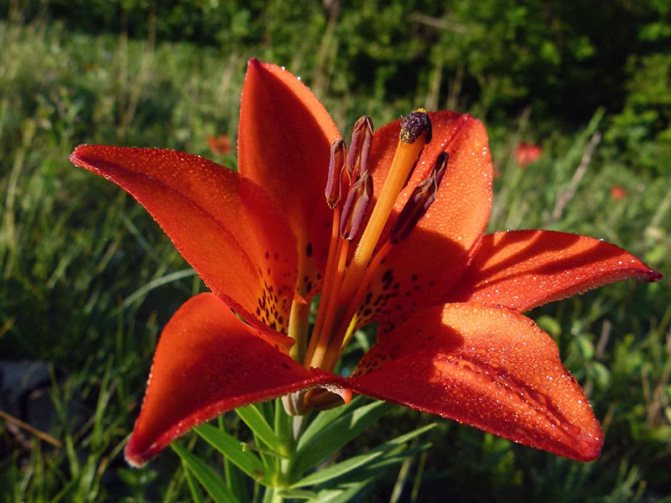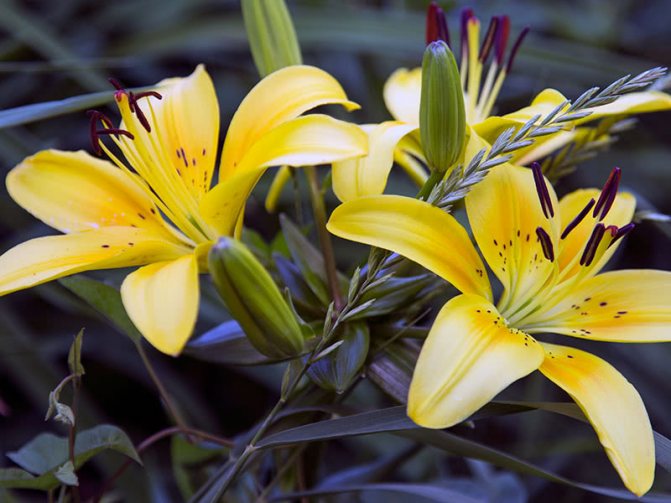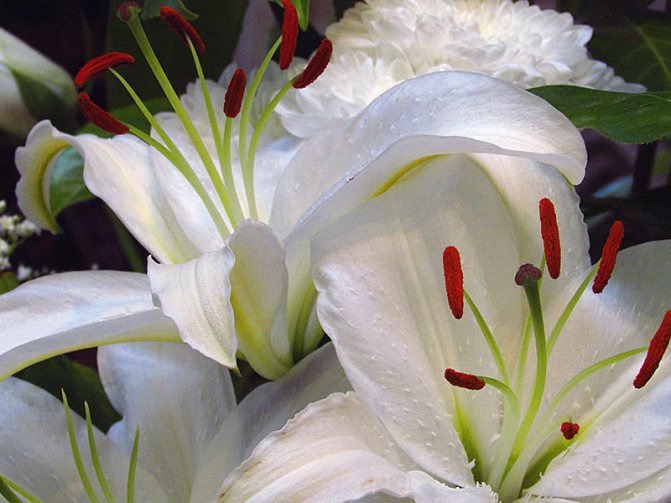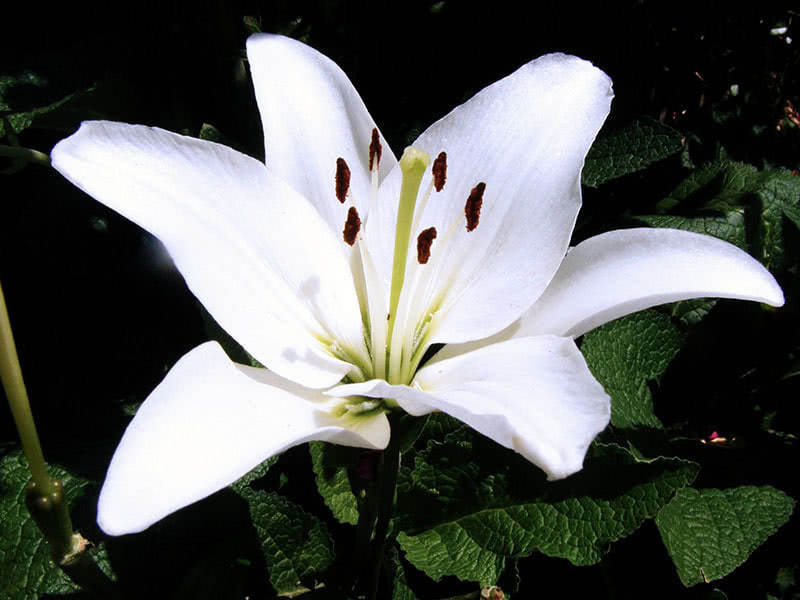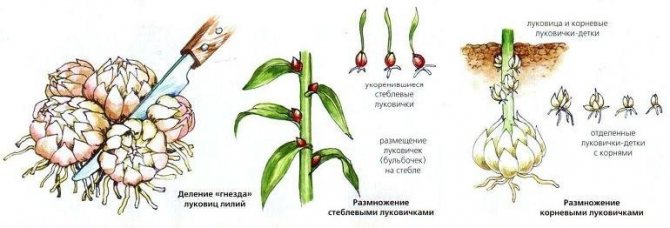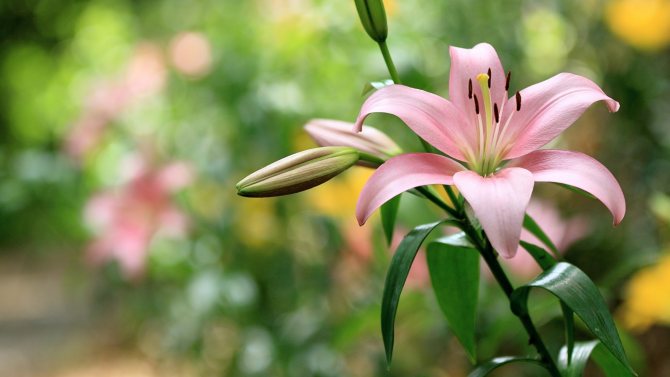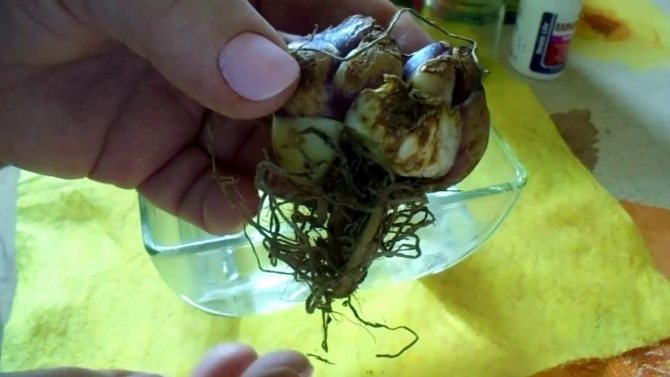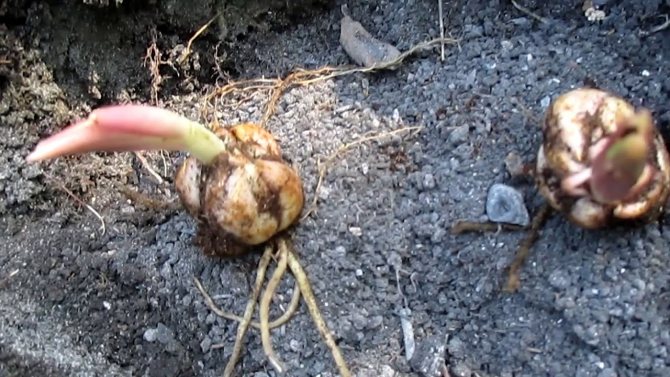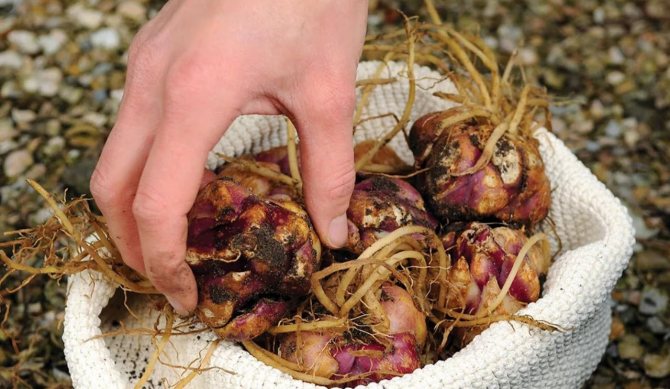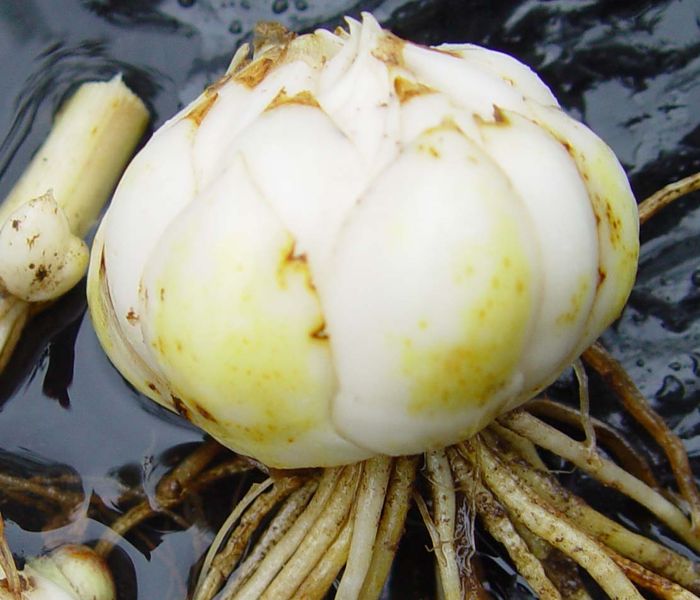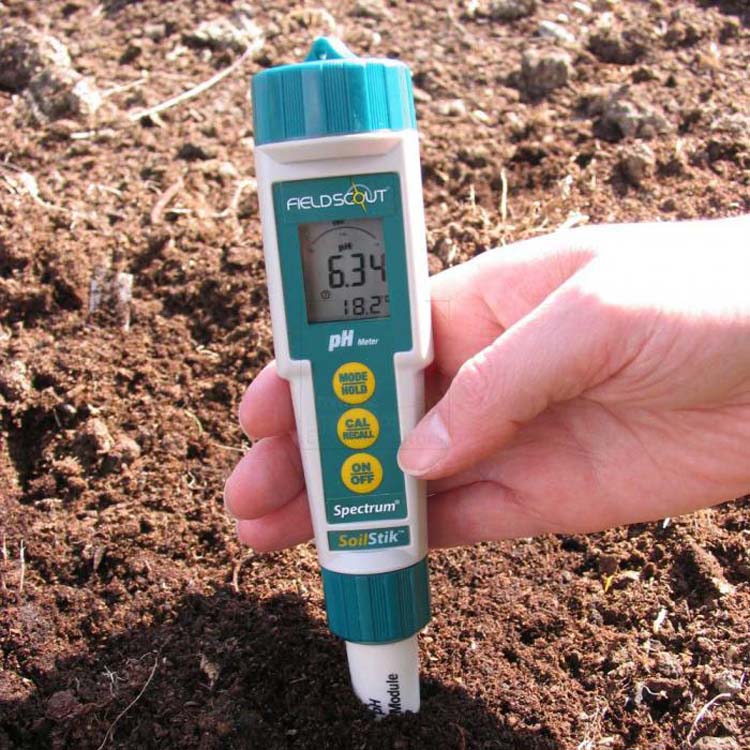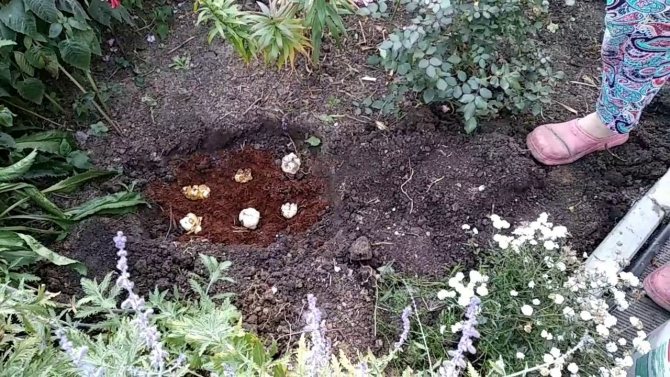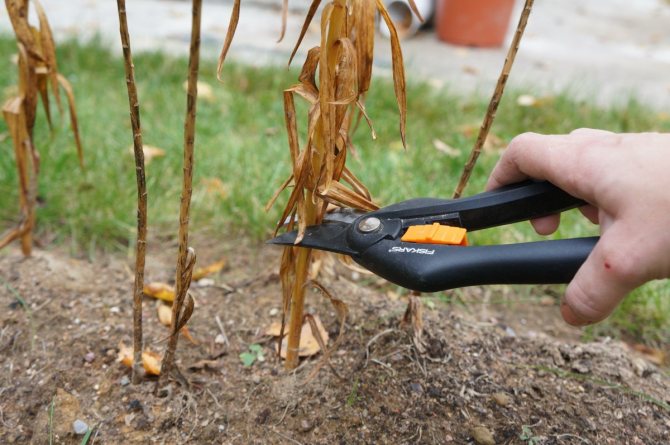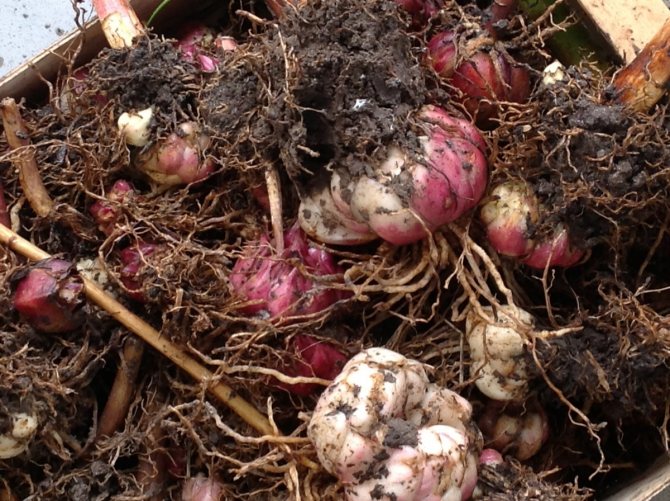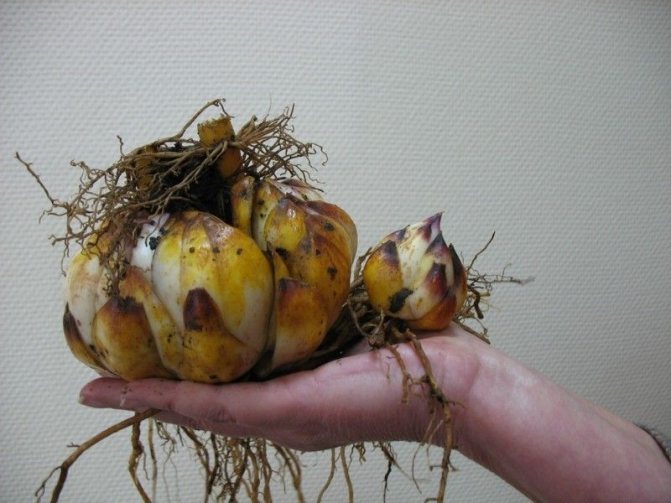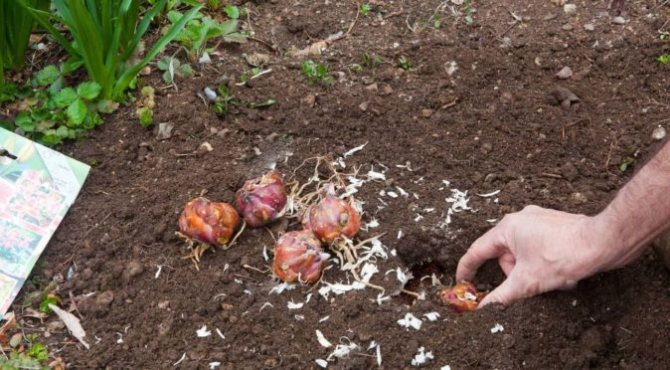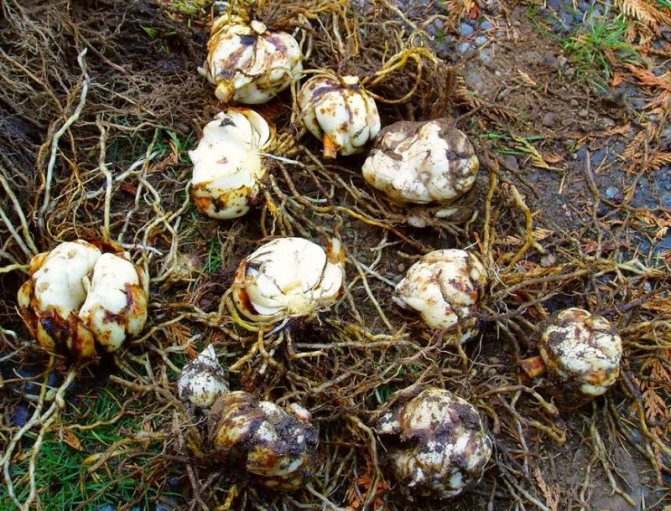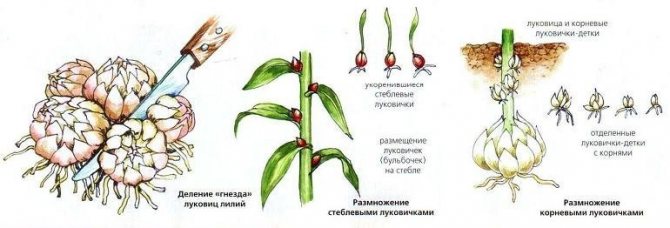Lilies are striking flowers that "catch" at first sight with their purity, elegance and beauty. It is no coincidence that we enthusiastically admire the bright colors and enjoy the easily recognizable notes of the fragrance of the so-called symbol of chastity. Many growers successfully grow them in their summer cottages, diligently multiplying them. How often to replant lilies? When is the best time to transplant? What should be the new location in the garden? It is appropriate to recall all this to those who, with enviable persistence, decided to give the magnificent flowers even more of their time and energy.
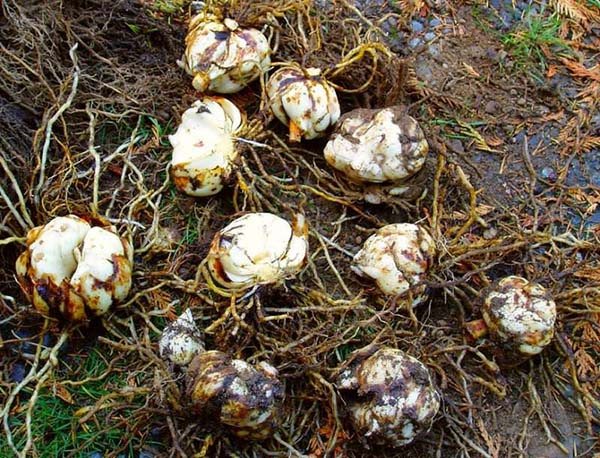
Planting lilies in the fall: when and how to plant in open ground
This culture loves warmth. It is planted in April, after the snow melts, or in the fall. In dry weather, plants need watering. They need to be covered for the winter.
The best planting dates are from early September to early October. Then the bulbous specimens will get stronger and beautiful flowers will sprout in the spring.
Planting lilies in the fall: when and how to plant
Planting plants in the autumn is not only possible, but even necessary. At this time, the bulbs are dormant, the risk of harm to them is minimized. The material planted before winter will bloom early, the plant will have a high resistance to spring frosts. In addition, over the winter, the bushes will have time to take root in a new area and take root.
Planting lilies in the fall
Important! It was found that flowers planted in autumn give more babies compared to lilies planted in spring.
Before you start planting lilies, you need to take into account the climatic features of the region. The planting period also depends on the variety. For example, Candium, Asian hybrids, oriental varieties are planted in Moscow and the Urals in late summer, and in Siberia in mid-August.
When lilies are planted in the ground in autumn, experienced flower growers:
- from mid-September to the end of October in the areas of the Middle Strip;
- from early September to October in the Urals;
- all September in Siberia;
- from early September to mid-November in Ukraine and southern Russia.
In warm regions, lilies can be planted in October and until mid-November, when autumn is not cold.
Important! It is not worth pulling to the last with the laying of a perennial lily, otherwise the root system will not be fully formed before the beginning of winter and the bush will die.
If it is not possible to plant the lilies within these periods, the bulbs can be saved until next year by insulating them with dry oak leaves. And if the florist is late with the planting, you can put a wooden box on top of the planting and cover it with waterproof material. This creates a small space for air circulation so that the bulbs do not get blocked during winter.
When can lilies be planted outdoors in short autumn? In this case, it is better to plant the bulbs in November. For autumn sowing, "dormant material" is suitable, that is, the one that has faded and dug out this year.
How to store bulbs before planting in the fall
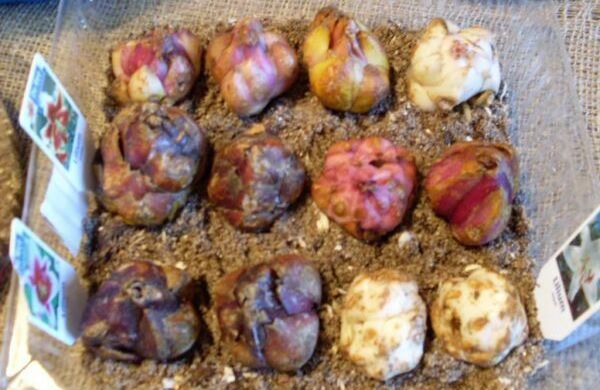

The ideal option would be to immediately immerse the lily bulbs in the ground immediately after removing them from the ground and taking the necessary measures (separation, disinfection). This option is possible if the grower transplants his own flowers to a pre-prepared area and can dig up the lilies before the transplant.
When buying bulbs from a store or if it is impossible to plant immediately, lilies must be properly preserved.
Important! When buying lily planting material in August - September, you should give preference to varieties grown in our country. Dutch varieties and hybrids at this time are sold from last year's dig, since the collection of planting material is carried out there in November. For planting, it is better to take the freshest planting material.
The bulbs themselves should be firm, well-rooted, free from rot and mold. If there is mechanical damage on the scales, sprinkle the wounds with crushed charcoal.
To preserve the viability of lily bulbs, they are provided with a storage temperature in the range from 0 to +5 and high humidity. At home, the easiest way is to place lilies in a perforated plastic bag with a handful of damp peat or sawdust. The package is placed in the refrigerator in the vegetable storage box.
Important! Apples, pears and tomatoes should not be stored in the immediate vicinity of lilies. Volatile substances emitted by products have a negative effect on flower bulbs.
If at the dacha it is not possible to put lilies in the refrigerator, they can be placed in a cellar, a glacier. Some growers pack the bulbs in an airtight bag and lower them on a rope into a well. From such a "storage" lilies must be periodically taken out and allowed to breathe.
Preparing for planting sites and bulbs
Particular attention should be paid to the air temperature. If lilies are planted in very warm weather, they can germinate. This should not be allowed, otherwise there will be no positive result. Landing is carried out at temperatures up to 10 ° C.
Important! Additionally, you can see in the lunar calendar which days are favorable for events.
Soil selection
It is better to plant bulbs in a well-lit area that is protected from the wind. The soil is chosen loamy, sandy or drained. The plant does not like heavy, dense, clayey territories. Do not plant where groundwater is close. The roots can rot and the plant will die.
Note! The root system of some varieties of lilies can grow up to 2 m.
The acidity of the soil is also of great importance for the lily. Tubular hybrids, Candidum take root better on neutral or slightly alkaline soil. For other varieties, planting on loam is preferable.
The soil will need to be loosened up for better oxygen access and delivery of water to the roots. The earth is dug to a depth of 40 cm. In the process, 100 g of superphosphate and 50 g of potassium sulfate are added per 1 m². The culture has a positive attitude to the introduction of peat, compost (5 liters per 1 m²). If the soil is light, only the first component will be sufficient.
Planting material processing
It is important to choose the right bulbs. The germination and development of the lily depends on them. The planting material must be healthy, free from defects, damage, rot. It is preferable to choose bulbs that are large, firm, without softness. Medium sized onions will sprout well, but may not flower until after a year. Small ones will definitely not give flowers in the first year of planting.
Tips for preparing your own bulbous material:
- you need to cut the stems slowly, leaving 5-10 cm from the ground;
- the plants are dug up with a pitchfork, so the root system will remain intact;
- lilies shake off the soil, get rid of dried foliage, herbs, cut off the roots;
Preparing a lily bulb
- it is possible to disinfect the bulbs with the help of a weak solution of potassium permanganate or means of foundationol, benomyl. Processing should last at least 30 minutes;
- then the planting material is dried in the shade for a day. This should not be done in the sun, since the onions will dry out completely.
Preparatory work before landing
Before starting work, it is necessary to prepare a new area where the flower will grow.It is necessary to take into account not only lighting, moisture and soil structure, but also be guided by aesthetic taste. Lilies are grown for the sake of spectacular flowering, which means that the flower should be placed near resting places or in the front area of the site so that the plant is always in sight.
Site selection and soil preparation


For lilies, choose well-lit areas, protected from strong gusts of wind. Penumbra (laced from trees or complete shading for several hours a day) is tolerated by Asian species, curly, LA and OT hybrids.
The selected area for flowers should not be located in a lowland, a ravine, where melt and rainwater accumulates, moist air stagnates. In such a place, lilies are affected by rot. Do not plant flowers in places with a close occurrence of groundwater (closer than a meter to the surface).
Lilies with high stems and large flowers are planted near buildings, fences, for protection from the wind. Alternatively, for plants, they provide for the installation of decorative supports and fences from the wind.
Advice. Placing a lily in a flower garden, it is recommended to plant perennial ground cover plants around it: undersized bells, primrose, creeping phlox, sedum, thyme, alissum, periwinkle. These plants will not only complement the beauty of the lily by filling the "lower floor" of the flower garden with flowers, but also protect the soil and bulbs from overheating in summer and from freezing in winter.
Preparing the land for lilies requires a serious approach - the flower is picky about the structure and fertility of the soil. A loose, fertile, well-drained, but moisture-consuming substrate is suitable for lilies. The most suitable are loams with a large proportion of sand, black soil and sandy loam. The rest of the soils need to be refined to bring them in line with the requirements.
The soil, containing a large percentage of clay, poorly permeable to air, is dug up, adding up to 10 kg of coarse sand per 1 sq. m. Often, sand is replaced by ASG - sand and gravel mixture. Gravel, up to 1 cm in size, as part of the mixture, loosens the soil well and is used to create a drainage layer when planting bulbs.
Depending on the type of lily, the flower needs a different acidity of the substrate:
- tiger (Asian) lily needs slightly acidic (pH about 6) soil;
- curly neutral or alkaline (pH 7-7.5);
- tubular lily only alkaline (pH 7 to 8);
- oriental lilies and OT hybrids, the soil is selected slightly acidic (pH 5.5-6.5);
- LA hybrid is planted in neutral soil (pH 6-7).
You can determine the acidity of the soil using test strips, which are purchased at the garden store. The weeds growing on the site also speaks of the acidity of the soil. Sorrel, horsetail, sedge grow on acidic lands. On neutral and alkaline - shepherd's purse, wheatgrass.
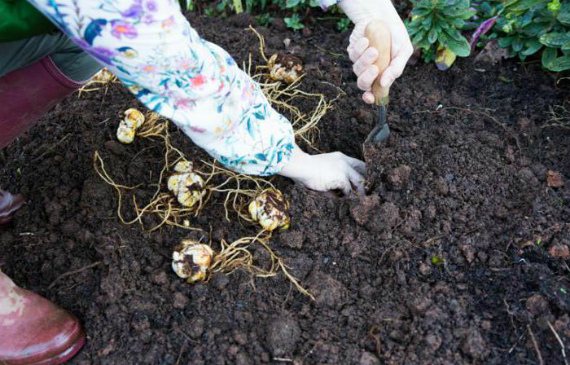

The soil is acidified with peat, coniferous litter. It is brought in up to 5 kg per 1 sq. m. You can neutralize excess acidity with wood ash (2 glasses per 1 sq. m.), lime or bone meal (glasses per 1 sq. m.), rotted manure (up to 5 kg per 1 sq. m.).
Important! Fresh manure or non-rotted compost must not be added to the soil for planting lilies! It promotes the spread of fungal diseases.
In addition to humus, a complex mineral fertilizer (Kemira flower, Fasko, Raduga, AVA) is used as fertilizer for planting. Or add 40 g of superphosphate and 20 g of potassium sulfate for each meter of the garden for digging.
Accounting for predecessor plants
To avoid contamination of the bulbs with diseases, lilies are planted after plants that do not have common diseases with them. It:
- legumes (peas, lentils, beans);
- decorative cereals;
- annual flowers (phlox, petunia, morning glory, flax, carnation);
- cucumbers, zucchini;
- radish, greens.
Do not place lilies after other bulbous plants (tulips, hazel grouses), asters, strawberries, onions and garlic.The flower can be returned to its original place of cultivation after 3-4 years. If the crop rotation cannot be observed due to the small size of the flower garden, it is enough to completely change the surface soil layer, 25 cm thick.
Preparation and processing of planting material
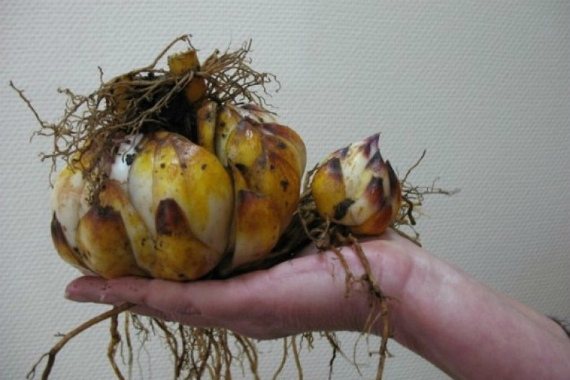

Immediately after being removed from the soil, the lily bulbs are examined and sorted: with signs of disease, they are sent for discard, healthy ones are put aside for further processing. The baby is sorted by size; bulbs with a diameter of at least 1 cm are suitable for planting.
Selected, outwardly healthy bulbs are freed from the remains of stems and dry scales.
To protect the plant from disease, the onions are immersed in a fungicide solution for dressing. Use:
- deep pink solution of potassium permanganate;
- Fitosporin;
- Maxim;
- Karbofos (3 g per 1 liter of water).
Etching time - no more than half an hour. After soaking, the bulbs are allowed to air dry for a few minutes and planted.
To protect the onions from mice and shrews, the planting material is coated with odorous substances: Vishnevsky's ointment, birch tar, solid oil. The pungent smell will scare away lovers of eating juicy bulbs.
How to plant lilies with bulbs and bulbs in the fall
In order for the lily to take root better, you need to know how to properly plant in the autumn.
- form holes for planting;
- put a drainage layer on the bottom;
- make a small hill of sand and plant a specimen;
- cover it with fertile soil;
- pour boiled water;
- insulate with compost, peat, sawdust.
The last manipulations will help keep water in the soil longer and protect the horse system from frost.
Bookmark depth
For a good wintering, the planting material must be immersed to the desired depth. It is related to the lily variety:
- Large bulbs of tall plants are immersed 15-20 cm deep, small ones 12 cm long. The length between plantings is from 25 to 30 cm.
- Large bulbs of medium-sized lilies are placed in the soil 12-15 cm, small ones - 10 cm.The distance is kept at 20-25 cm.
- Low-growing lilies are laid to a depth of 10-12 cm large material, 7 cm - small. The distance between plantings is 15-20 cm.
Important! If the plant is planted too deep, the material will germinate for a long time. But after a certain time they will have a lot more children.
Instances can be placed in the wells or laid out on the prepared groove. To do this, make a layer of sand 2-3 cm to protect the material from decay.
Important! For autumn planting, you need to carefully straighten the roots so that they do not stretch to the sides. Then they are sprinkled with earth, slowly pressing the soil against the bulb.
Planting sprouts
Flowers with sprouts can be planted when they reach a height of 20 cm. In a circular motion, gently remove the shoots from the bulb. It's great when the whole sprout comes out. Seating is carried out in the usual way. The only thing is that you need to build a comfortable shelter for them. It is impossible to delay planting, it is better to hold events 2 weeks before October.
Planting lily sprouts
If the sprouts are longer than 20 cm, you should not dig them out, since such a planting will not bring any result. You can only plant them in a tall pot and grow them at home. Proper planting, attention, feeding with nutrients, watering will help to get healthy lilies. Transplanting into open ground is carried out at the end of May.
Propagation by bulbs
Lilies are propagated not only by bulbs and sprouts, but also by seeds. These bulbs are formed in the leaves of plants. When they fall to the ground, they begin to sprout, turning into full-fledged adult flowers. But not all varieties produce seeds. To this are located the tiger lily, Asian hybrids, some tubular. After germination of the bulb, the plant will bloom for only 3 years.
Self-planting bulbs makes sense only in the autumn season. In the ground for some time they increase, in the spring they begin to germinate.
Can all varieties of lilies be transplanted in the fall
From the moment of flowering to the digging of the bulbs of the plant, at least 5 weeks should pass (optimally - 7-8 weeks). This time is enough for the bulb to accumulate nutrients necessary for adaptation in a new place. Lilies blooming in August - September may not have time to ripen for transplantation and suffer from frost in winter. Most often, this applies to Eastern hybrids.
For residents of the northern regions of the country and Siberia, autumn transplantation is possible only for early flowering (in June - July) varieties of lilies. The rest of the specimens are dug out for transplanting in the spring.
Important! Lilies transplanted in spring do not form flowers in the first summer. If the buds have formed, it is better to cut them off so as not to weaken the plant.
How to plant lilies in the fall
Despite the fact that this perennial plant can easily grow in one area for 4 years, after a while many varieties have children. Their number increases from year to year, and the flowering of the mother sprout decreases. Therefore, they need to be separated.
The vast majority of Asian hybrid lilies produce such an impressive number of babies that some growers recommend replanting them every year. The rest of the perennial varieties form little shoots. This refers to oriental varieties and tubular. Some varieties do not give children at all. In the conditions of the Middle Lane, this is understandable. They lack summer warmth, sun rays.
Important! Perennial lilies should always be watched. If the feeding is correct and timely, watering is regular, all the rules of care are observed, the number of children is under control, but the plant does not bloom well and its appearance has deteriorated, then it’s time to transplant it to a new place.
How often should lilies be replanted?
For most varieties of lilies, the period of their active development when grown in the same place, as a rule, is from 3 to 5 years, after which they must be transplanted to another place, because by this time the bulbs grow in the colonies, become very small, and therefore, their flowering ceases to be so attractive and lush.
By the way! Asiatic and tubular lilies require replanting every year.
Further care
No special care is required after sowing lilies. Everything is extremely simple. Watering is carried out if the autumn is dry. The pests are not yet infect, since the shoots have not yet appeared. No processing is carried out. It is transferred to the spring season. You can water through plastic bottles.
Before the onset of stable frosts, the soil is insulated with needles, dry leaves, branches. In addition, mulching will protect future sprouts from snails and slugs. These measures are taken if a frosty winter with little snow is expected. If the weather is moderate, it is not worth covering additionally. 10 cm of snow cover is enough for protection from freezing temperatures.
Correct planting technology, good flower care will preserve the bulbs and help their further growth in the spring. Growing lilies and caring for bushes is not so difficult, the main thing is to take into account all the nuances described above.
Lily care after autumn transplant
After filling the hole with soil, the lilies should be watered abundantly, and the soil should be mulched with a layer of loose peat, hay dust or sawdust. Mulch, 10-15 cm thick, protects the soil from drying out and freezing.
In regions with an early arrival of cold weather and a small amount of snow, lilies are additionally insulated. To do this, the mulched bed is covered on top with a piece of film or agrofibre (it is better than film, since it allows air to pass through), and up to 40 cm of fallen leaves, hay, sawdust are poured on top. In the spring, when the snow melts, the shelter can be easily removed by lifting the agrofibre along with the mulch.
Rules for planting lilies in the fall
Let's talk about lilies, planting and care in the open field in the fall, after flowering. Today, it is impossible to imagine a fashionable garden or a large flower bed without this lovely, mesmerizing flower. The variety of hybrids is striking: frost-resistant, strong-smelling, odorless, with a lot of pollen, without anthers, blooming for a long time, etc. They are undemanding and beautiful, they will delight even the most sophisticated grower.
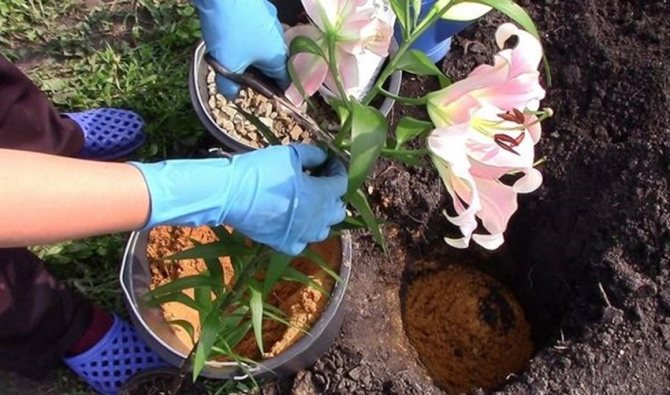

What lilies can be planted in the fall in the suburbs
All types of lilies are suitable for growing in the Moscow region. Weather conditions and modern shelter materials will allow even eastern and tubular species, which are distinguished by their special beauty, grace and aroma, to winter.
You can plant before winter:
- All varieties of Asiatic lilies. They are the most unpretentious and frost-resistant among all. They differ in compact size and colors of a wide variety of shades. They look great in group and single plantings. Growing in flowerpots is possible. Have no aroma. Worth oh, Red Twin and Double Seishen.
- LA hybrids. They were bred on the basis of Asian varieties and adopted from them resistance to cold. From long-flowered species, they got a graceful inflorescence shape and a bright aroma. They are widely used in landscape design. The lilac variety Noman or the bright crimson Manhattan will certainly attract the attention of florists.
- OA hybrids. Gardeners will be pleased with the large funnel-shaped inflorescences of oriental lilies and, again, the endurance of Asian lilies. There are still few varieties, but breeders consider this direction very promising. Today, the proven Crown series is available, featuring a large number of inflorescences, and the new Red Power or Kokopa varieties.
- OT hybrids. Biologists have combined the elegance and grace of tubular lilies and the splendor of oriental lilies in a hybrid, and have improved the characteristics of capricious species, giving them resistance to frost. Snow-white Coconut or bright Altars will take their rightful place in the garden.
.
When organizing a good shelter, planting of oriental or tubular lilies is also possible. But given their finickyness, it is better to postpone it to the spring.
Why is it important and how to correctly determine the timing of disembarkation
The rules for planting, transplanting and leaving are not that complicated. The main advantage of the autumn planting of lilies is that the bulb will have time to root thoroughly before the onset of frost. A strong, well-developed root system will provide quality nutrition, will be the key to the correct development of the aboveground part of the plant and active flowering. But if the transplant is organized in the spring, then the flowers, most likely, will not have to be seen this year.
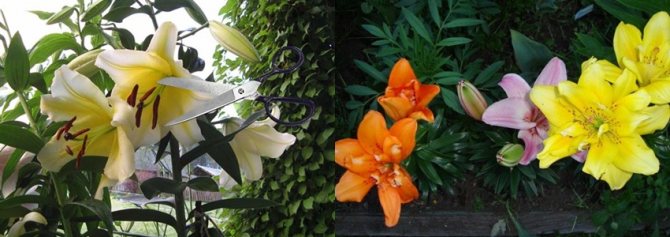

When and how to plant lily bulbs correctly depends on the climatic zone. In the south of the Russian Federation, this is done in October, in the Moscow region - throughout September, in Siberia and in the Urals - at the end of August or September. The approximate dates are indicated, but it is better to be guided by the general rule.
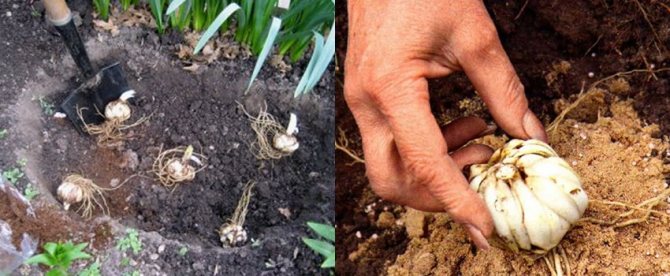

It is important to observe this rule, because late planting is extremely dangerous, because there is a great risk of freezing, and if you hurry, the plant will start growing. Autumn shoots on the surface of the soil will certainly suffer from frost, and the flower as a whole may die. Long-term weather forecasts will help you choose the exact time for planting lilies outdoors.
Timing
In matters of transplantation, we rely on the characteristics of the variety. And here, early flowering lilies and lilies with medium flowering times seem to be more suitable for the middle Russian latitudes. The early varieties bloom in late June-July, while the middle ones finish blooming in mid-August. As a result, by the time of the planned transplant, they have time to rest and gain strength. Accordingly, August and September are the best times to transplant lilies. If you schedule a transfer at a later time, you will have to carefully monitor the weather all the time.
In the case of a late transplant, you need to take care of shelter for the winter so that the bulbs do not freeze out.In addition, late transplanting provokes inhibition of peduncle development in the next season.
Late varieties, pleasing us with flowering all September, will have to be left until spring. In mid-latitudes, a late autumn transplant will not do good.
Photo gallery of common varieties of lilies
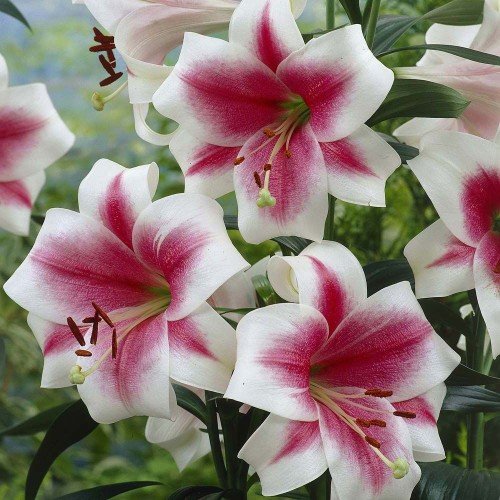

Variety "Triumfator"
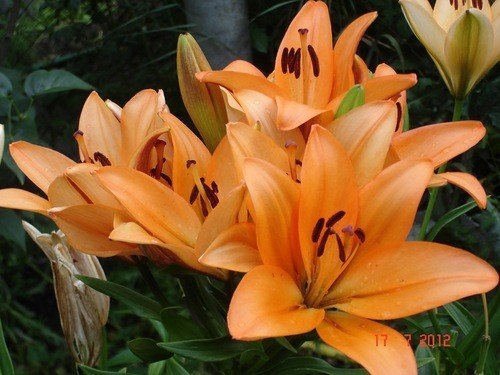

Variety "Indian Diamond" "Variety‘ Henry "Variety" Leopardovaya "Variety" Curly "Variety" Armenian "
Choosing the bulbs and the site
Ahead of the planting material tests of severe frosts, thaws, temperature "swings", cold winds. To get the maximum survival rate and a beautiful garden bed, choose specimens:
- at least 3 cm in diameter.
- dense to the touch. It is better not to plant soft-bodied bulbs, they can become a source of disease and do not sprout in spring;
- free of moldy areas and suspicious stains;
- at the bottom of which white tubercles are visible - the rudiments of the roots. If this area is affected by rot, then the lily is disposed of.
Site selection plays an equally important role. La-hybrids, tubular and Asians are best suited for maximum sun, in extreme cases, light shading is allowed. But oriental beauties and martagons feel better in the semi-shady parts of the garden. All lilies, without exception, reproduce poorly and bloom in heavily blown places, but weak drafts that prevent air stagnation will only benefit the flowers.
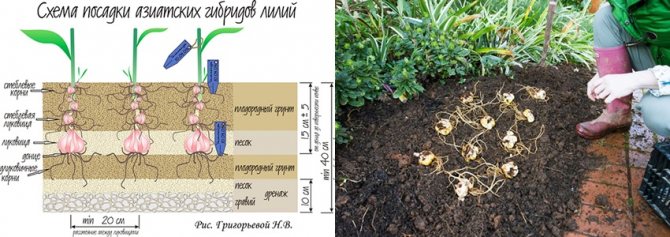

Pre-planting preparation and disinfection
If a dried stem is preserved, then it will certainly be cut off. Carefully dig out the nests with a shovel, trying not to injure the underground part of the plant. Bulbs of all sizes are carefully selected from the ground, shaking off the remains of the soil. The collected "crop" is washed under running water and allowed to dry in the shade.
Pre-planting preparation begins with an examination of the roots. Broken, blackened, dented, dried roots are to be removed. There will be no benefit from them, only harm. If the root system is too long, then it must be shortened to 3 - 5 cm. Next, the bulb is examined, the blackened lifeless scales are cleaned.
Pre-planting disinfection is mandatory for all planting material, especially for new specimens purchased in shopping centers. Such dressing agents as "Maxim Dachnik", "Fundozol" are quite widespread and affordable in price, therefore they become the drugs of choice for a modern grower. How to make the solution and the holding time of the bulbs in it are clearly spelled out in the instructions. Read the manufacturer's information carefully and observe the indicated proportions.
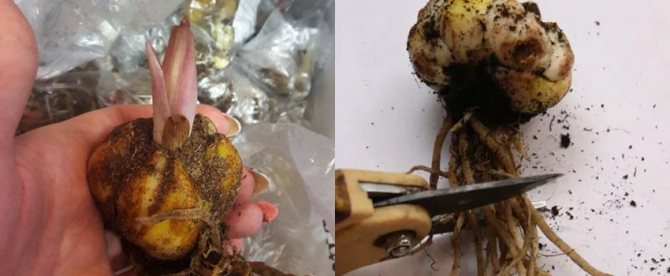

Do I need to dig lilies for the winter
Not all lilies can endure winter frosts without loss, especially for tubular varieties, which even a carefully equipped shelter cannot save from low temperatures.
Therefore, they need to be dug out at a certain time:
- OT hybrids - in the last days of August;
- oriental varieties - in September;
- LA hybrids and Asian hybrids in mid-August.
After removing the material from the ground, it is carefully examined, damaged and dry elements are removed, and washed in running water. In the future, it is kept for 20 minutes in a weakly saturated solution of potassium permanganate and dried.
A wooden box or a dense bag is used as a container, filled with peat. It is unacceptable to keep the bulbs at room temperature, the best option is from 0 to 5 °.
It is preferable to choose a place that is darkened (otherwise premature plant growth will begin) with moderate humidity, increased indicators provoke the occurrence of mold and fungal diseases.
The best way to store daylilies is to place the seed in special heat chambers and put them on the loggia, if we are talking about apartments, or in the basement.
During the entire hibernation period, it is recommended to systematically check the condition of the bulbs.In case of excessive dryness, spray with water from a spray bottle, in case of decay, treat with potassium permanganate.
Algorithm for planting in open ground
The algorithm will tell you when and how deeply to plant the planting material. Here it is:
- dig a deep enough hole and water thoroughly.
- A layer of fertile soil is poured at the bottom. The thicker it is, the more nutrition the sprouts and peduncles will receive.
- Then a layer of clean sand is poured.
- A small hill is made on the sandy layer and an onion is carefully placed on it without pressure, spreading the roots around the hill. At this stage, it is important to ensure that the roots are not bent upwards, this will harm the plant.
- Sand is poured over the entire height of the bulbs. Such a "pillow" will protect you from rotting and fungal colonies.
- They are covered with earth to the top.
- Water again if the soil is dry.
- Mulch.
The recommended depth depends on the size of the planting specimen. We embed it in the soil for 3 diameters of the bulb. This is important, so you can avoid freezing or untimely appearance of shoots on the surface of the earth. The planting scheme depends on the variety, the lilies are planted at least 15 cm apart.
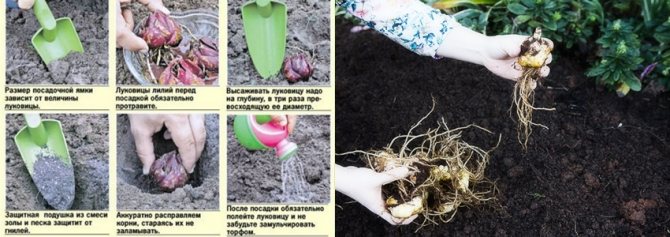

A few words about planting tall varieties
Curly lily is an absolute record holder among tall varieties and can grow up to 2 meters. Also, many hybrids exceed 1.5 meters in height. Such plants have a massive stem, a heavy leaf mass, a large number of flowers, therefore they must be securely fixed in the soil.
Planting and care in the open field in the fall of tall varieties of lilies has a number of features. The root system in such specimens is formed both under the bulb and above it. The roots absorb a large amount of moisture, which is much greater at depth than in the upper horizons. Freezing of the soil is slower, because the lily is only for a minimum time in unfavorable conditions, which reduces the risk of dying in the winter.


Transplant procedure technology
Garden lilies are transplanted in accordance with certain agrotechnical rules and requirements. If everything is done correctly, the bulbs will quickly take root, the plants will be strong and healthy, they will bloom luxuriantly and brightly. They can be placed separately from other flowers or combined with them, planting together in flower beds.
Disembarkation scheme
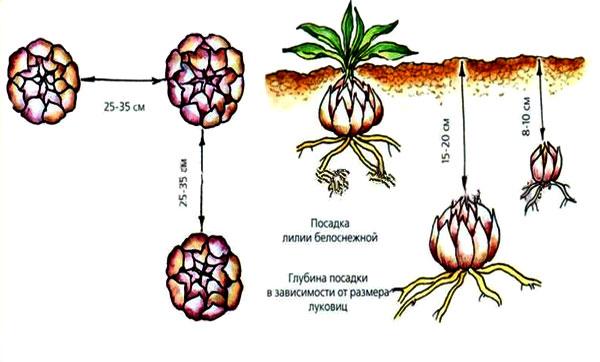

For the successful development of plants, they must be provided with a certain area of nutrition. The distance to be kept between the bulbs depends on the variety. For example, for bulbs of low-growing varieties, it is necessary to leave 8-10 cm, for medium-sized ones - 10-15 cm, tall ones will have to be planted at intervals of 15-20 cm.When planting in the holes, a little coarse sand is poured into it, the bulb is planted, it is covered with soil on top , watered and mulched with any plant material or a piece of agrofibre.
Embedment depth
For each lily, dig a hole, the depth of which should be equal to three times the diameter of the bulb. This is the best option, with such a deepening they will feel most comfortable. It is not necessary to deepen it below, as well as to locate it too close to the surface of the earth.
Proper preparation for winter
Preparing lilies for wintering is an important process, especially for flower growers in the northern regions, where the temperature drops to -40 grams. Celsius and below. First of all, zoned varieties are chosen, this will reduce the risk of plant death in the winter cold. For example, the following are suitable for the entire middle lane:
- hybrids Asian, OA, OT, LA;
- lilies daurian, pennsylvanian, marchagon.
These flowers winter well and do not require digging for the winter. But the Eastern, Tubular, American hybrids are poorly adapted to bitter frosts, therefore they require a special approach in the fall. For such delicate bulbs, growing in greenhouses is ideal. But if you have to spend the winter in the open field, then you cannot do without shelter.
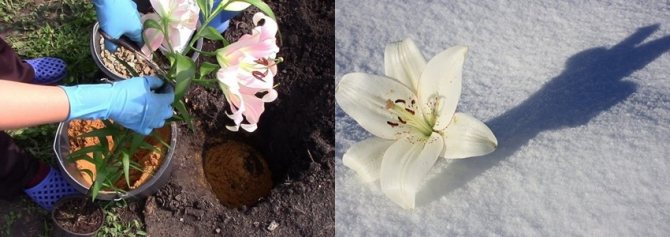

The ideal winter shelter for all types of lilies is a layer of coniferous litter. Gastropods, which gladly feast on young plant sprouts in spring, will not be able to climb under such mulch. But if there are no needles, then the soil is mulched with dry peat or fallen dry leaves. If the site is heavily blown by the wind, then the protective layer is covered with agrofibre.
With the onset of the first thaws, the agrofibre is removed and the mulch is removed in a timely manner. This is necessary so as not to weaken the plant while young shoots are forced to break through the artificial barrier.
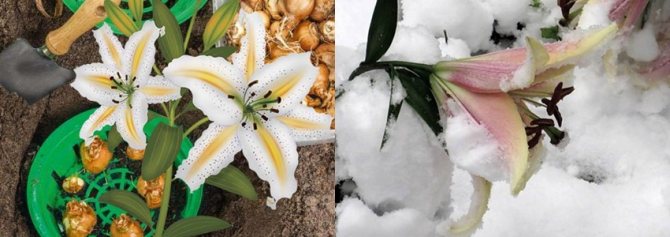

Post-transplant period
Lilies, with the exception of oriental hybrids, do not suffer from frost and do not need shelter. The exception is when the transplant was made late, and you are not sure about the safety of the bulbs. Here dry leaves or coniferous spruce branches will help as insulation. Only after the snow melts, it will be necessary to quickly get rid of this layer so that the bulbs do not swell.
No problems with watering are foreseen, since autumn itself is quite rainy time. Only in the case of a prolonged period of drought in the warm period of autumn, a small amount of watering may be required when the land is completely dry. With the onset of cold weather, this need disappears.
If the soil where the lilies are transplanted is heavy or damp, it will need to be diluted with sand or some other baking powder. Lilies do not like to live in loams and high dampness, they are more pleasant with loose nutritious soil. It is forbidden to use manure as fertilizer, no matter how high quality it is. The thing is that manure enhances the growth of the vegetative bulbous system, which has a bad effect on the bulb itself, as well as the winter hardiness of the plant and the quality of flowering.
Already in the next season, when the plant will build up its green mass, abundant watering will be required in June and immediately after flowering. You need to water at the root, without soaking the leaves, the roots of the lily are long - up to two meters.
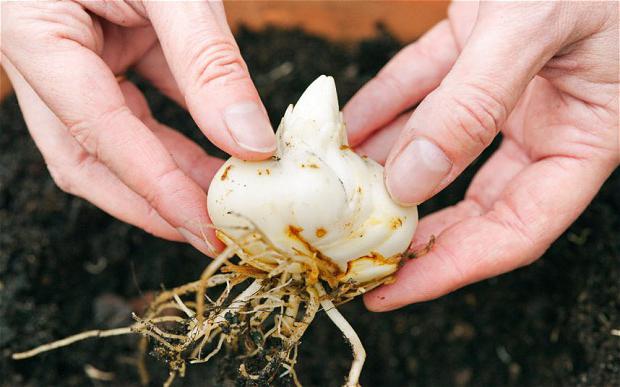

Lily roots are long - up to two meters, an unusual size for flowers
In the spring, before the appearance of lily sprouts, it is advisable to feed with mineral and organic fertilizers. Wood ash, for example, can increase the size of flowers and give them a brighter color. The quality of flowering depends on the health of shoots and leaves, therefore, after the appearance of lily buds, you need to feed and process the ground part of the plants from diseases and pests again.
For the winter, lilies are covered with spruce branches, polyethylene and covering peat. The latter may not be removed in the spring, but it is better to remove the spruce branches as soon as possible so as not to destroy the sprouts.
Features of working with non-standard planting material
But what if you really do not want to throw away non-standard bulbs that did not fit the usual criteria for planting material suitable for planting in the fall? There is no need to be upset, it is important to follow some simple rules and wait for abundant flowering.
Planting small children and bulbs
In the North, where the frosts are more than -40 degrees, it is better to plant small children in boxes or separate containers, and to transfer them to open ground together with a lump of earth during a period when the threat of spring frosts has passed. In all other regions, the bulbs are planted in well-loosened soil to a depth of 1.5 - 2 - 3 cm, depending on the diameter of the planting material. They mulch only with peat or oak foliage, make sure that in the spring the shelter is removed without delay, but not too early.
Planting bulbs with sprouts
In stores, you can sometimes see planting material with sprouts that have already hatched. You can buy such copies at a symbolic cost, which is beneficial to any florist. If you really want to make such a dubious purchase, then you do not need to deny yourself the pleasure. But, the technology of autumn planting will change.
As soon as the sprout reaches 18 - 20 cm, try to remove the shoot from the bulb as carefully as possible with clean, dry hands. This process is best done with rotational movements, turning the sprout either clockwise or counterclockwise. Next, plant the lily without breaking the planting time. Most likely there will be no flowering next year, the planting material is injured and it needs time to recover and accumulate strength. But in a year the plant will delight you with large flowers of full size and shape.
Preparation of planting material of lilies for autumn planting
Before starting the autumn planting of lilies, you need to pick up a good planting material. We carefully examine the bulbs, if there are sick and damaged bulbs, we select them. If the roots on the lily bulbs are dryish, then they are cut off, but if you see that the roots are very long, then they can also be trimmed. Having chosen good bulbs, we put them in a medium solution of potassium permanganate. Thus, our planting material is disinfected. If there are spots on the bulbs, then treat them with Fundazole or Carbaphos, cutting off the damaged areas before processing. What lilies are not planted in autumn, see here.
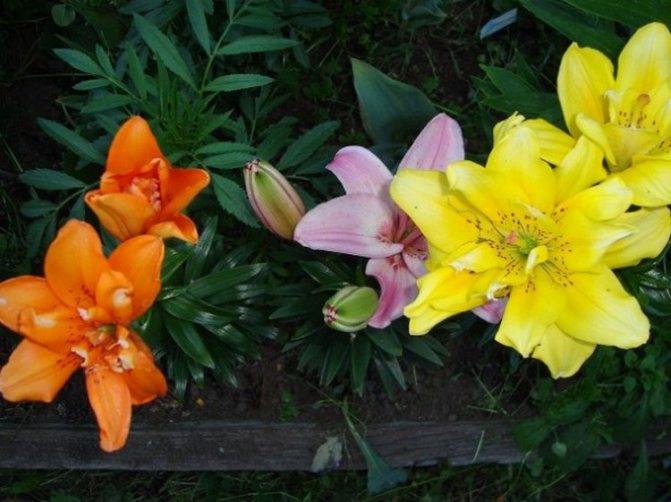

conclusions
Planting lilies in the fall after flowering is considered agrotechnically justified, and then leaving in the open field does not take much time and effort. If you follow simple proven advice, you can avoid the degeneration of the planting material, and annually receive a friendly flowering throughout almost the entire summer. Lily is very unpretentious both in soil selection and in care. Correct planting, pest control and at least a few top dressing are the minimum for which the flower will be grateful and responsive. Lily beds are a bright accent and decoration of any garden.
What if the bulb has sprouted?
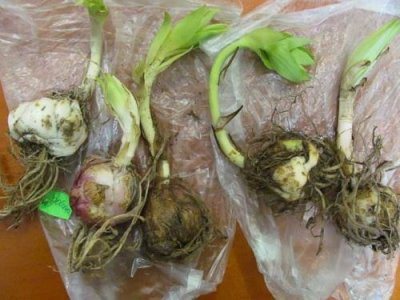

In the fall, such a nuisance can happen if the bulbs are planted not in a dormant state, but prepared for distillation.
This happens when buying from dubious non-specialized outlets, where dishonest sellers pass off low-quality goods as good ones.
ATTENTION! In addition, any bulb can germinate in the presence of two components - heat and moisture.
If it is a very warm autumn and it rains periodically, the lily can become entangled in the seasons and sprout. Can sprouted lilies be planted in autumn?
There are several ways to plant lilies in the fall with sprouts:
- dig up the bulbs and wait until the sprouts are 1 to 2 inches high. Then, very gently, with rotary movements, pull the shoots out of the tuber. Plant the bulb back and carefully cover it for the winter, because it will be very weak and may not tolerate frost;
- more time consuming and troublesome. Dig a bulb with shoots and plant at home, growing as a houseplant all winter;
- dig up the onion and disassemble it into individual scales. Plant them in a greenhouse for germination. Then, instead of one big dubious bulb, you will get many small lilies that will bloom in a couple of years;
- just cover the sprouted tubers well using coniferous spruce branches, sawdust, peat and covering material, in the hope that the sprouts will go into a dormant state and wait for spring safely.
Pruning dead lilies
At the end of flowering, the growing season for lilies does not end. Now the underground part begins to grow, in which future flower buds are laid. At the same time, nutrients come not only through the root system from the soil, but also from the aboveground part, which processes solar energy. The processes of photosynthesis continue in the stems and leaves, the resulting substances are vital for the full maturation of the bulb.
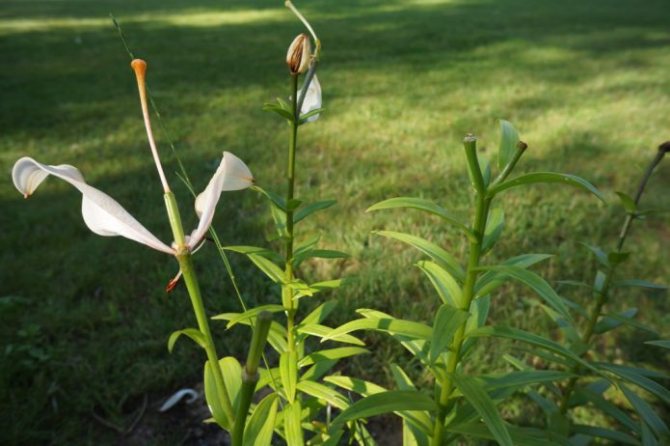

After flowering, the stems of lilies cannot be cut off immediately.
If you cut off the faded stems too early, then the underground part will immediately stop growing. Lily will not be able to get the food she needs and will be frail.She will hardly survive the winter, and the subsequent flowering will leave much to be desired. It is recommended to remove only wilted flowers from the seed pod that has begun to form, so that the ripening seeds do not take away the vital juices from the bulb.
Some gardeners practice pruning lily shoots to a height of 20-25 cm.
You need to cut the flower stalks of lilies with a sharp and disinfected tool (pruner, knife, etc.). It is better to cut the cut obliquely in order to avoid the accumulation of precipitating atmospheric moisture (dew, rain) at the cut site and subsequent decay.
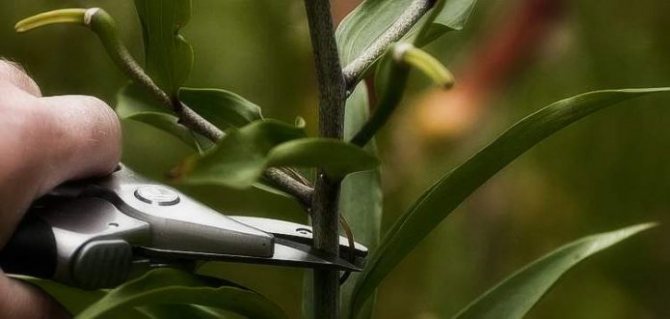

You need to cut the stems with a sharp and disinfected garden tool.
Since faded lilies look completely unattractive, so that they do not greatly spoil the general appearance of the flower bed, I cut them in parts as the stems dry out. In front of them, I try to plant fast-growing annuals (marigolds, petunias, etc.), which will hide ugly drying shoots.
Video: partial pruning of lilies after flowering
Seat selection
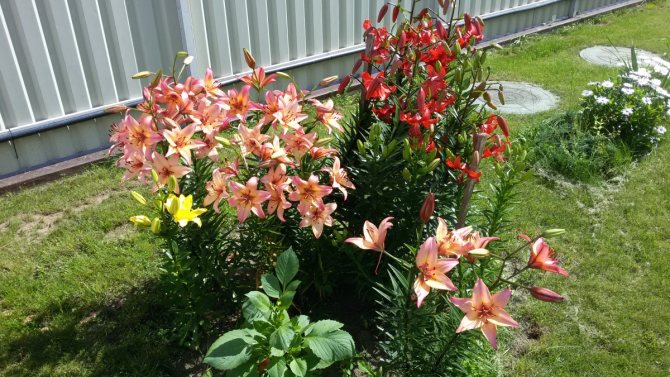

Lilies should not be planted in shaded areas.
Lilies feel comfortable in areas protected from wind and drafts. The degree of illumination depends on the variety of colors:
- Asian, tubular and LA hybrids need maximum access to sunlight;
- oriental lilies and martagons will begin to fade in the sun, so they are planted in partial shade.
The level of acidity also depends on the variety: there are varieties that are planted in acidic, slightly acidic and neutral soils. A detailed recommendation can be found on the bulb packaging and in the specialist literature.
Lilies cannot be planted in the place where they grew earlier. It is also unacceptable to place it on a site where asters, garlic or strawberries were located. The best predecessors for culture are legumes and annuals: violets, petunias, snapdragons. Planting after radishes, cucumbers, cabbage of all kinds is permissible.
Fertilizing and watering lilies after flowering
After flowering, during the active growth of the bulb, lilies need fertilizing with fertilizers with an increased concentration of phosphorus and potassium.
- potassium monophosphate - 25-30 g per 1 m 2;


After flowering, lilies need potassium-phosphorus fertilizing.
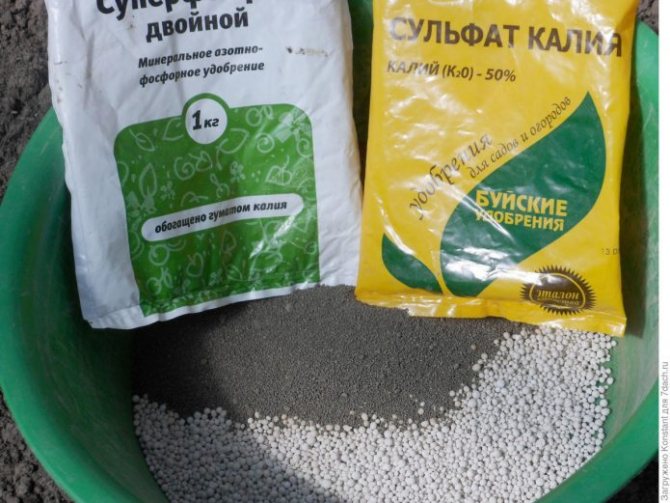

Potassium sulfate and superphosphate (dissolved in warm water) are used to fertilize lilies together in the form of an aqueous solution
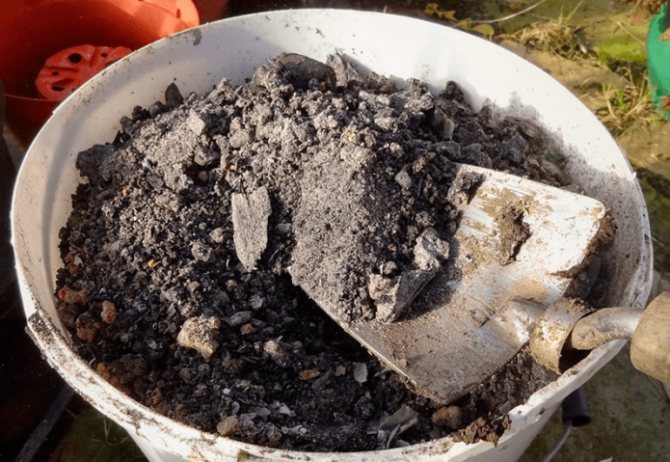

Wood ash should be spread evenly under the lily bushes.
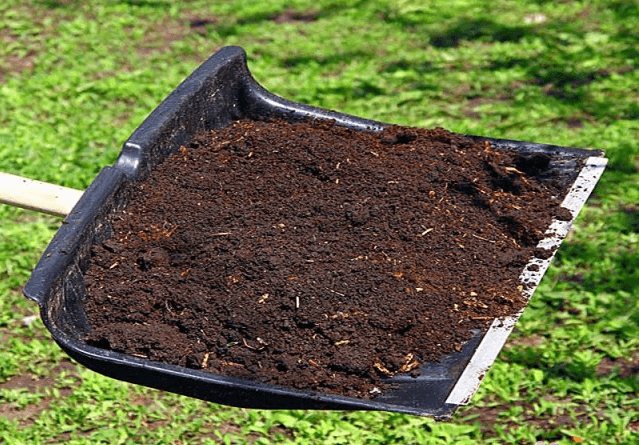

Humus is used as mulch and fertilizer
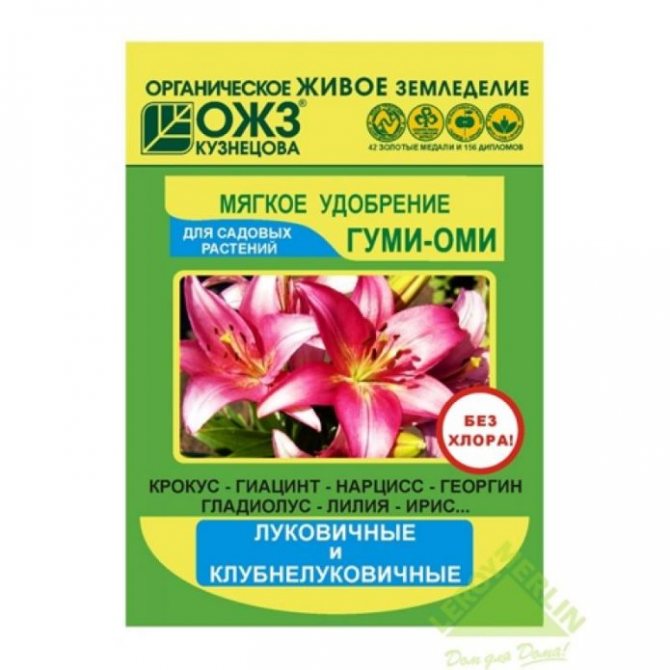

It is best to use specialized mineral complexes for bulbous crops to fertilize lilies.
All fertilizers are best used in liquid form, as they are absorbed faster and better by plants. You need to make additional fertilizing no later than the beginning of September, because later the lily already begins to prepare for wintering and assimilates them poorly.
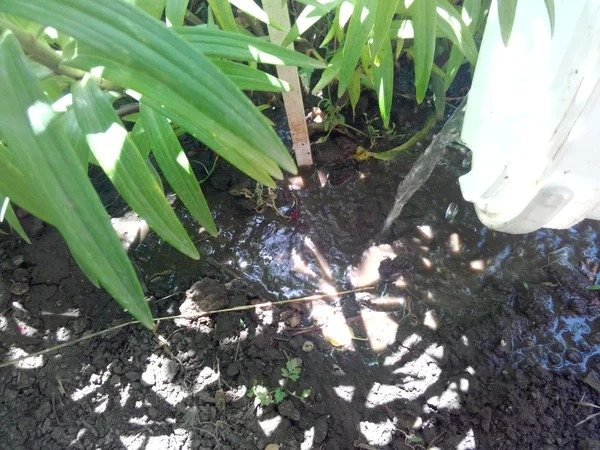

It is better to feed the lilies with fertilizers diluted in water.
It is not recommended to use nitrogen-containing substances in autumn, as they delay the ripening of the bulbs and postpone the dormant period.
As the planting soil dries up, water, remove weeds and loosen the topsoil.
Benefits of an autumn transplant


It is recommended to transplant lilies in early autumn. An autumn transplant has a number of advantages:
- the plant has recovered after summer flowering and has accumulated enough strength to adapt to a new place;
- over the summer, enough babies have grown on the mother plant, which is convenient to separate and plant immediately;
- autumn weather is favorable for transplanting - it is still warm and there is enough precipitation;
- The gardener has more free time than in the spring.
There are only two contraindications to transplanting lilies in the fall: late flowering and a cold climate, with the onset of frost in September. In order for a lily bulb to take root in a new place, it needs to spend at least 4 weeks in non-frozen soil.
Lilies: when is it time to dig up and replant
It is not necessary to dig out faded lilies every year, they feel great without transplanting for 4–5 years. But sometimes such a need arises, and it is due to the following reasons:
- the need for plant propagation;
- individual characteristics of the variety (low frost resistance, etc.);
- the appearance of signs of diseases (rotting, blackening of the stems, etc.);
- a decrease in the size of flowers - a bush that has been growing in one place for more than 5–6 years is overgrown with children, as a result of which the flowers become smaller.
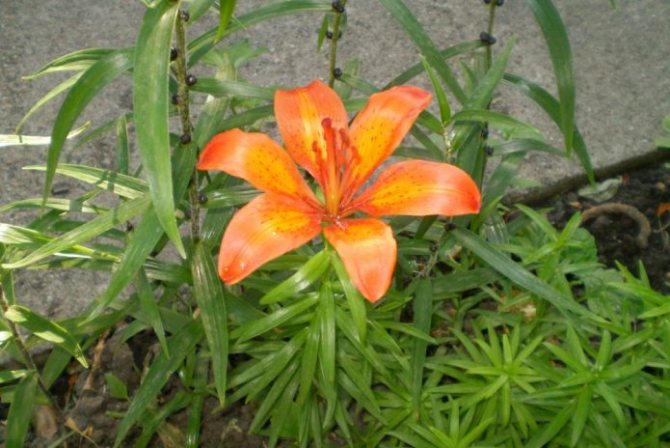

If the lily is not transplanted for a very long time, then gradually the flowers become smaller
It is possible to extract lilies from the ground only after the ground part has completely died out, while the stems should fade on their own. This usually happens 4-6 weeks after flowering ends. Most often, plants are dug up in August or September (depending on the flowering time), when they have already entered a state of dormancy and will tolerate this procedure much more easily.


It is recommended to dig up lilies after the stems have completely wilted.
Many modern varieties of lilies need to be dug up and transplanted on average once every 3 years.
The work is carried out using the following technology:
- Cut off dried stems.
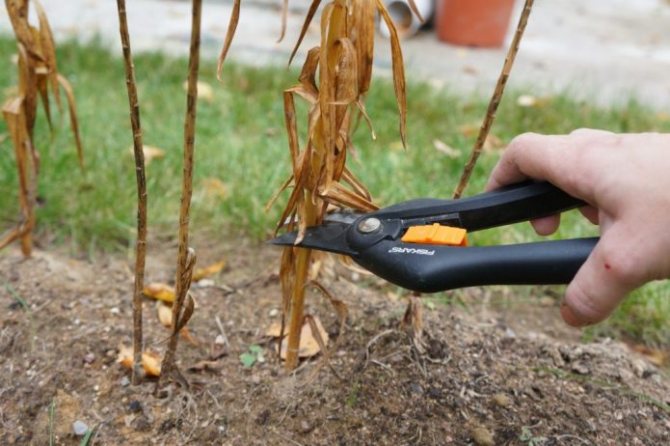

Before digging up lilies, cut off the dried stems
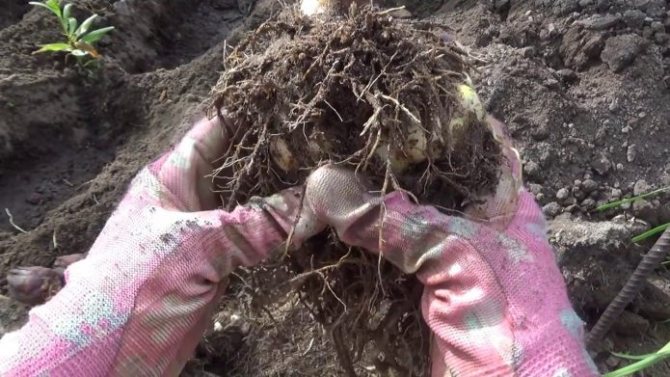

Lily bulbs are dug up and freed from the remains of the earth
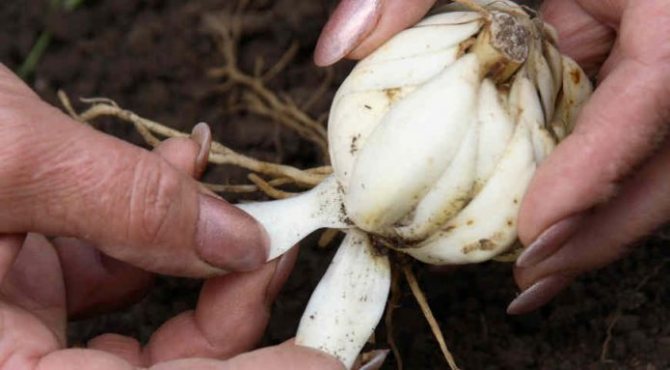

Lily bulbs are carefully examined and diseased scales are removed


Children are separated from the mother's bulb
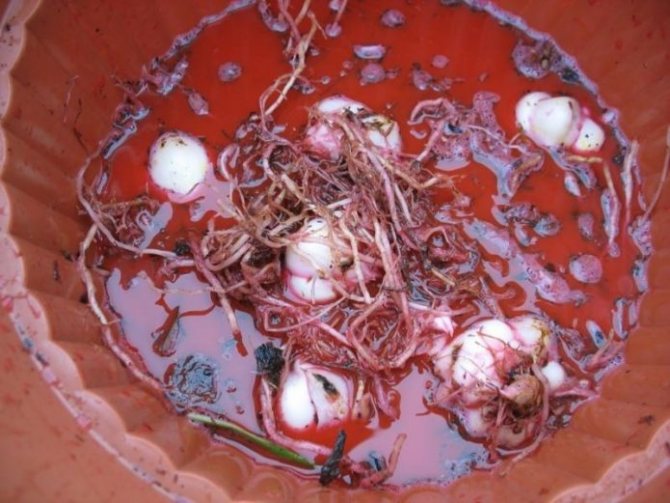

The bulbs are soaked in a solution of potassium permanganate or other disinfectant
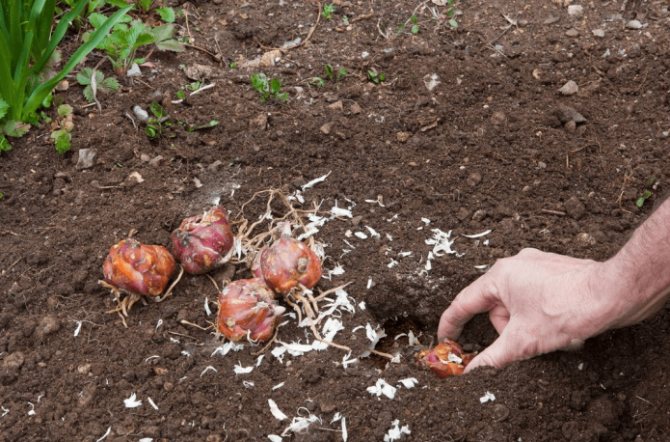

Dug up lilies can be immediately transplanted to another location.
Video: when and how to transplant lilies correctly
When shoots appear
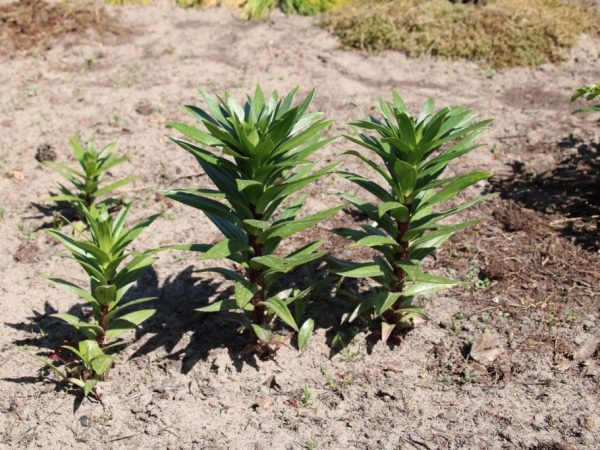

Weather conditions affect plant growth
The first shoots of lilies planted in autumn fall in the spring.
The month depends on the type of flower:
- tubular are activated in growth in March-April;
- Asian - in May.
Also, the growing season can fluctuate depending on weather conditions. Flowering generally begins in mid-June and lasts until the first days of August.
Such early varieties as Alyonushka or Mona Lisa release a peduncle in May. The late ones can be admired in August-September.
Wintering and storage of lilies
Winter-hardy varieties of lilies survive the cold outdoors very well. For better safety, the plantings are mulched with humus, straw, peat or other plant residues and covered with agromaterial.
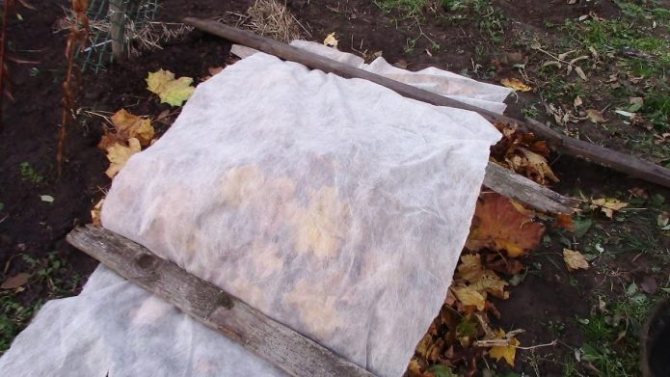

Lilies are covered with a layer of dry leaves and covered with agrofibre
But some capricious hybrids require annual digging and storage in a relatively warm place with an air temperature of about + 2 ... + 3 ° С.
You can store lilies:
- in a cellar or basement;
- in the refrigerator (on the bottom shelf or in the vegetable compartment).
Well-dried bulbs are placed in shallow wooden or plastic boxes, then sprinkled with a mixture of coarse sand, sawdust and peat. It is allowed to store lilies in boxes, shifting them with layers of sphagnum moss or burlap.
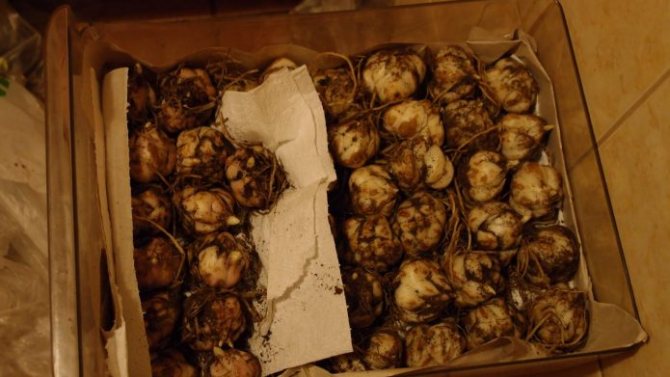

To store lilies in the cellar, the bulbs are laid out in shallow boxes or boxes.
Before laying for winter storage, lily bulbs are treated with insecticides (Fufanon, Karbofos, etc.).
To be kept in the refrigerator, the onions are placed in polyethylene bags with moistened peat or wrapped in a damp natural cloth.
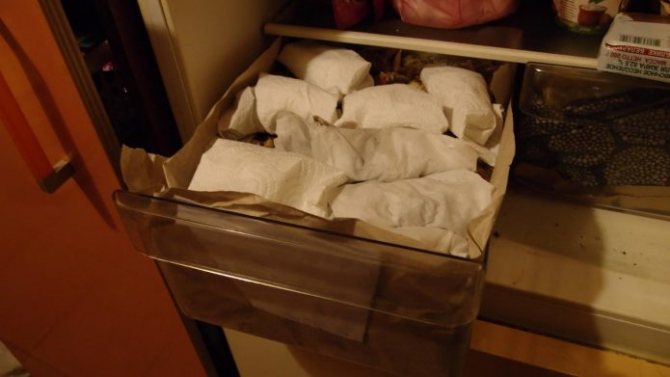

Lilies can be stored in the refrigerator by wrapping them in a damp linen cloth
It is necessary to constantly monitor the humidity so that the lilies do not dry out and, if necessary, lightly sprinkle the substrate.
Even frost-resistant lilies do not always survive the winter safely, sometimes they still freeze out. In order to guarantee not to lose the plants, I usually leave half of the bulbs to winter in the ground, and store the rest in boxes with wet sand in the cellar.
Video: recommendations for storing lilies
Lily transplant: step by step instructions
The procedure consists of three stages:
- Dig holes to match the size of the bulbs. The depth should be such that the ground hides the rhizome by 4–5 cm.If the tubers are large, the hole is deepened so that the roots feel free.
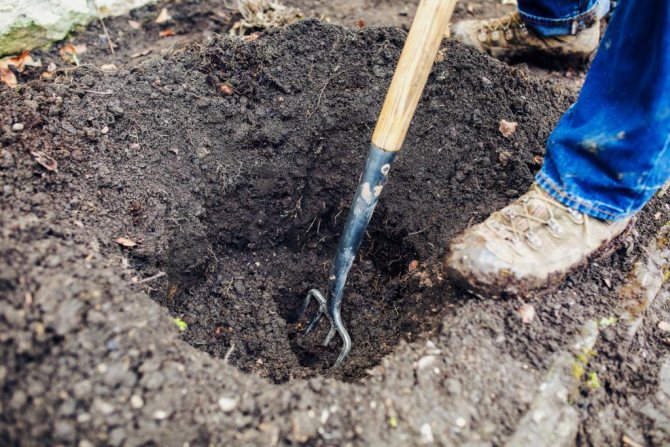

- The bottom of each hole is covered with a small layer of coarse sand. An onion is placed on it, the roots are also lightly sprinkled with sand. The bulb itself should not be hidden by the sand.
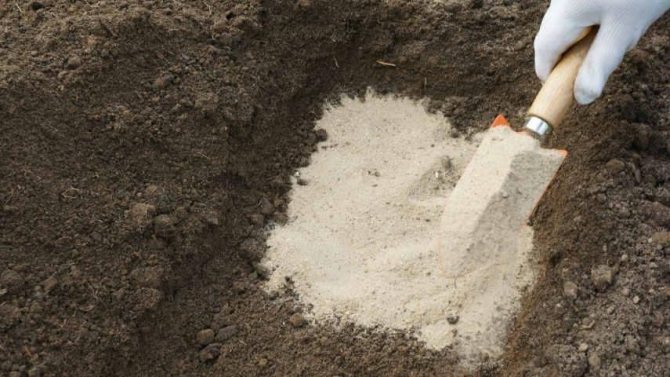

- The hole is covered with earth, the soil is leveled. It is advisable to put a small layer of peat or sawdust on top: in winter it will protect from the cold, and in spring it will turn into fertilizer.
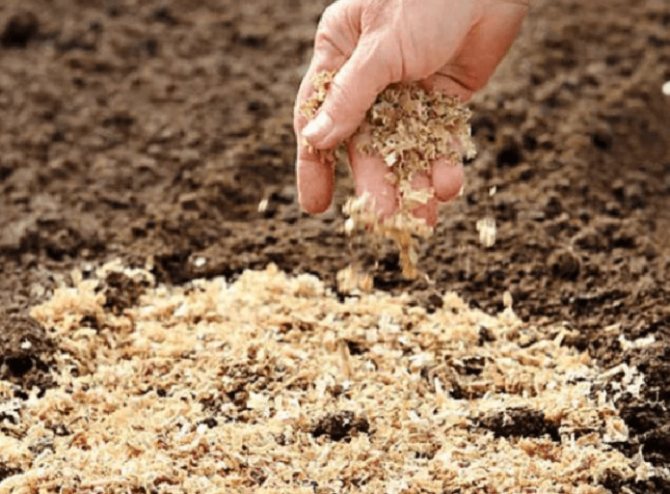

Even a beginner can handle planting bulbs.
Selection and processing of planting material
Regardless of whether the flower heads were dug out earlier in the area, or they were purchased from a store specifically for growing beautiful flowers in the garden, all seed must be properly processed before planting.
It is necessary to start the procedure for preparing the bulbs with sorting. First of all, all tubers are examined and laid out in size and grade. It is better to discard sore and soft heads immediately. Only dry and hard bulbs are suitable for planting. There should be no visible damage to the skin.
If the planting material has spots characteristic of scab or powdery mildew, some gardeners do not throw out particularly valuable specimens, but try to heal them. To do this, the lesion is cut out with a sharp knife and burned with garden varnish or ordinary brilliant green.
Planting flowers
Ornamental culture tubers are planted in pre-prepared trenches. Their depth depends on the size of the bulbs and is usually 3 times their diameter. Very large heads can be placed closer to the ground. If the plant is planted too deep, it will be more difficult for the shoots to make their way to the sunlight, but in winter a thick layer of soil will protect the flower tubers from freezing.
The distance between the rows of lilies should be at least 25-30 cm. This is necessary for the normal development of the root system of each specimen. The bulbs are placed in a trench with an indent of 10-15 cm.
At the bottom of each hole, a sand and peat cushion is made. The flower head is placed on it with the bottom down. It is necessary to slightly press the planting material into the soil mixture, but this should be done very carefully so as not to damage the root buds. Then the bulbs are sprinkled with sand and earth. The surface of the flower bed is watered and tamped a little.
To protect the flowers from frost, the site is mulched. Sawdust, fallen leaves, peat or straw are good for this. The mulch layer should be 4-6 cm. During the winter, you need to make sure that the flower bed is constantly covered with snow. This will create additional protection for flowers from severe frosts.
In regions with harsh climatic conditions during snowless periods, it is allowed to cover the site with a film. But this material does not allow air to pass through, so it is recommended to make small holes in it, and remove it in early spring.
Planting lilies in the open ground in autumn will allow plants to start a new life cycle in time and in summer to delight the gardener's eye with magnificent lush flowering.
The best time to plant lilies is in autumn - from late August to early October. The bulbs planted at this time have time to take root well, fully get stronger, and in the spring lilies that have started to grow will calmly endure the spring cold snaps.
But if you are lucky enough to buy sprouted bulbs now - in the fall. What to do with them?
With small sprouts, there is a way to get rid of them and plant an onion without greenery in the fall. This process requires skill, since the sprout should come out as much as possible. But you need to take into account the fact that the bulb will weaken, so it needs to be well covered for the winter.
- Wait for the sprouts to grow 20 cm in height.
- Gently pull them out of the onion, rotating them in different directions. The sprout should come out as completely as possible.
- After that, you can safely plant a lily, not forgetting to organize her shelter.
Lily bulbs with large sprouts, what to do in this case?
Lilies with large shoots are best planted in a tall pot.It will not be possible to preserve the bulb until the spring planting, since the sprouts will only stretch strongly over the winter, and those planted in open ground will continue to grow in the ground and die.
On a light-colored windowsill, with proper care, your lilies can even bloom. They should be watered and fed with liquid fertilizer for the flowers. In late May - early June, the plant is carefully removed from the pot, transplanted into the garden, trying not to damage the roots, for this the hole is made deep.
They also brought me onions with overgrown sprouts. In this case, you should not risk it, and I planted them in a deep pot. All sprouted instantly and had already gained color. As soon as they bloom, I'll put them in a cool place, and then I'll put them in the cold. And in the spring I will plant it in the ground as expected.
Bulbs with lily sprouts are best planted in spring.
Subject to the conditions for planting lilies with shoots, you can get a brightly flowering plant this summer. Sprouted bulbs are planted in the ground at the end of May, when severe frosts are already behind. Otherwise, tender sprouts may freeze.
The depth of the bulb depends on the degree of development of the sprout. If the sprout is still short, rolled up in a “tube” and the leaves on it have not yet opened, then you can plant it to the usual depth. For bulbous crops, it is three bulb heights, counting from the bottom. For different types of lilies - 12-20 cm.
But if the sprout on the bulb has already unfolded the leaves, then such a bulb cannot be planted deeply - only up to the sprout neck, without deepening it. The sprout will not be able to rise from the thickness of the earth and will rot. With such a shallow planting, there is a danger that the bulb will freeze in winter. Therefore, it is safer to transplant the lily bulb in the fall to the required depth.
Choosing bulbs for planting
An important rule for any plant is the careful selection of planting material. This process requires care and seriousness. There are several factors to consider when choosing lily bulbs:
- the bulb should not be less than 3 cm in diameter;
- to the touch, it is dense, without soft and sluggish places;
- if most of the bulb has rotten spots or mold, it is definitely not suitable for planting;
- the absence of rot and damage at the bottom of the bulb is just as important;
- the bulb should be free of sprouts and the roots should look healthy.
Fertilizers
As for fertilizers that need to be applied regardless of the condition of the soil, the following are distinguished:
- humus at the rate of 7 kilograms per square meter;
- sand and peat;
- 4 kilograms of humus per square meter for black soil;
- superphosphate.
It should be noted that when planting, summer residents make a number of mistakes and because of this they have problems, solutions to which will be presented below.
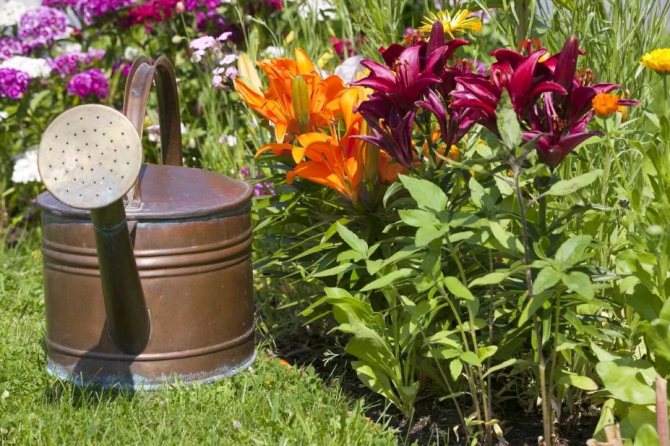

If a lowland is chosen for planting, you will need to pay more attention to the drainage system with the addition of expanded clay.
If the soil is poor, you can use disinfected Bogatyr-type composts, which can be purchased at a gardening store.
If the bulbs are planted in a sunny place, you need to add sawdust and plant nearby bells or peonies, which will shade the planting.
In whom the bulbs managed to become infected with rot or if the bulbs have sprouted, in this case soaking them in a 0.2% solution of the Fundozol suspension will help.
For example, flowers do not bloom well or wither. The problem is caused by waterlogging of the soil. To solve the disease, you need to reduce the number of watering to 1 time per week.
Interesting!
For inexperienced growers who just wanted to grow lilies, an Asian variety of flowers is better suited, which differ from other varieties in their resistance to cold and are tolerant of any conditions.
Boarding time
For my experience, I have tried planting lilies almost all year round. However, I came to the conclusion that the best planting time is that which nature itself has chosen.
If you observe the lily, you will notice that after flowering, the peduncle remains green for a long time. Careless florists cut it off. The motives for this action are not clear to me.I am clearly convinced that this cannot be done.
From the peduncle, nutrients pass into the bulb. The leaf also gives all the elements to the bulb. At this moment, it begins to grow. Its scales are enlarged, filled with nutritious juices and carbohydrates. It is thanks to them that next year I will have excellent flowering.
By the end of August, the peduncle almost completely turns brown. This is the start time for the transplant. The onion is full and is getting ready for bed. In its scales, all processes are already slowing down, and you can take advantage of this. (The sleeper is always easier to work with.) That is why the end of August and the beginning of September is the best time.
On the market, you can often see how the bulb is sold along with the peduncle and the flower. I also bought these more than once. It should be noted that they take root well, and next year they bloom, but not as chic as when sold.
It is completely different when trimmed bulbs are sold in the month of July. In this case, everything depends on the price. If it's cheap - I buy, plant, grow, I don't expect beautiful flowering in the first year. If it's expensive, I prefer not to buy. A bulb devoid of peduncle cannot take up nutrients on its own and may die.
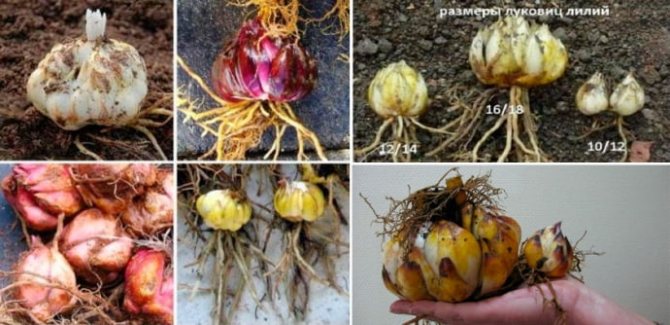

Wintering
In most cases, lily bulbs planted in autumn do not need insulation; natural shelter with a 10 cm layer of snow will protect them from freezing. In recent years, winters have become warmer, which leads to the absence of snow cover. If you are faced with such a problem, then you will have to cover the plants with your own hands. For these purposes, needles, dry peat or fallen leaves are perfect. The first is best, as there is a high risk of slug penetration when using vegetable mulch. They eat sprouting shoots, thereby destroying the growth point of flowers.
Planting lilies in the fall and hiding them is not a complete list of care for them. As the snow melts, you must free the plants from their winter coat. This should be done on time: if you are late - a lack of light will lead to a decrease in sprouts, if you remove them early - you risk freezing delicate shoots.
It is worth noting that some varieties are generally not advised to be left in the ground for the winter, unless you have special skills in botany. These include Oriental hybrids, as they are characterized by poor frost resistance and absorb moisture like sponges. For a successful wintering, the gardener must have some knowledge of creating an optimal environment for capricious plants. The worst enemy of these flowers is excess moisture, so make sure they winter in dry conditions.
Beauty for the lazy
As you have already noticed, there is a lot of work with the aristocratic lily. But, fortunately, there are less whimsical flowers that are not inferior to her in beauty - these are daylilies. Despite their external similarity and belonging to the class of monocots, they belong to different families. The first - to the liliaceae, the second - to the ksantorreevs. When to replant daylilies: in spring or autumn? This perennial plant will delight the eye for at least 5 years, and the older it gets, the more luxurious it looks. Every year more and more flower stalks and greenery are formed on it. Planting hemerocalis (its second name) can be carried out for almost the entire vegetative period with one caveat: it must be completed by mid-September. Unlike lilies, daylilies will take root better if planted in spring. In the case when you undertook to transplant daylilies in the fall, be as careful as possible and make sure that they do not freeze.
To transplant, dig out the bush and divide it by making the required number of notches at the base of the rhizome. Your task is not to damage the tender sprouts, so do everything carefully. Treat the plant with a fungicide and deepen the root collar a few centimeters into the soil.
Care advice
After planting the bulbs, an important step in the good growth of future flowers will be caring for them, which has its own nuances.
- feeding should be carried out with the onset of spring, before shoots appear with the addition of ammonium nitrate and a cowshed;
- in the middle of summer, to strengthen the plants, you need to add nutrients containing phosphorus and potassium;
- in annual plants, it is necessary to remove the buds. This will allow the flowers to bloom better in subsequent years;
- dead plants and dried leaves, which serve as carriers of infections, should be regularly removed;
- get rid of insect pests and their larvae, which eat the buds, and prevent flowers from growing calmly. It is recommended to collect them mechanically and incinerate in a specially designated place.
If all fertilizers are applied before planting, then there is no need for feeding. They do not start pest control in the fall, since they all either died or hid until spring. And with the arrival of frost, you need to prepare for the shelter of the plants so that in the spring they decorate the garden plot.
Features of planting daughter bulbs and bulbs
When to dig up lilies
For reproduction of lilies, daughter bulbs are usually used, which overgrow the adult, mother. A number of varieties, called bulbous, form such bulbs (buds) in the axils of the leaves. Planting fine material has a number of features.
Planting buds
The least traumatic way of breeding lilies, which does not require digging out the main bulb. Tiny bulb babies are found in many Asian hybrids, tubular, tiger and selected varieties.
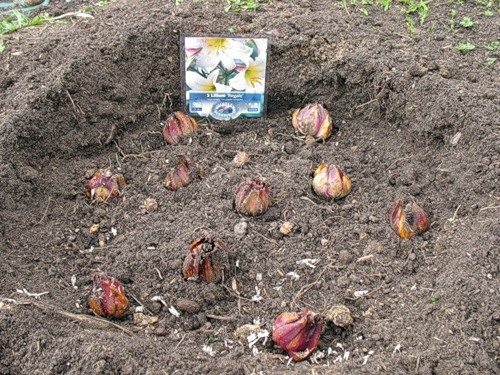

Planting buds
The babies finally ripen by the end of the flowering of the mother plant: they are easily separated from the stem; some manage to release small roots, less often - miniature leaves.
Even if the reproduction of lilies is not included in the gardener's plans, ripe children are collected so that the flower beds do not become clogged with unnecessary shoots. If the goal is to breed this variety, then they prepare in advance for planting baby bulbs:
- choose a place for a school bed, better shaded;
- they dig up the soil, at the same time introducing a special fertilizer for lilies or a mixture of ammonium nitrate (30 g / sq. m), potassium sulfate (10 g / sq. m), superphosphate (10 g / sq. m).
Ripe bulbs immediately after collection are kept in a weak solution of manganese for 2 hours for disinfection, then planted in grooves about 3 cm deep with a step of 5-6 cm, covered with earth and watered well. After watering, lay out a layer of organic mulch.
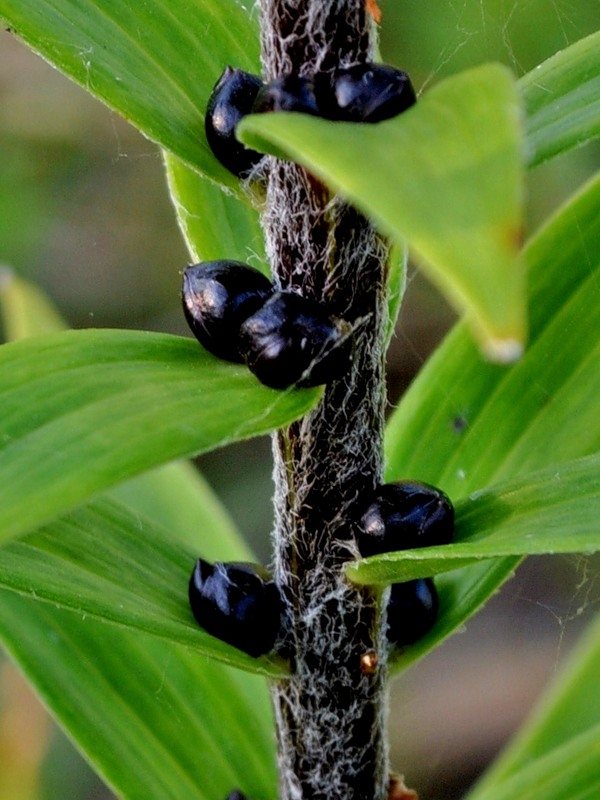

Lily bulbs
Bulbous lilies are frost-resistant, therefore, young growth does not need shelter for the winter. As insurance for the schools, dry foliage is raked up, covered with spruce branches.
Planting baby bulbs
This method of reproduction provides for the regular digging of the mother plant every 3-4 years in order to separate the babies from the main bulb. The best time for this is a month after the end of flowering, when the main bulb has recovered and got stronger. Some varieties do not need to be dug out, because babies are formed on the underground part of the stem, it is enough to shake off the soil, sift it.
Such bulbs are planted on school beds, prepared in the same way as in the previous case, only the planting depth is 3-5 cm, and the step is 10-12 cm. The process of preparing daughter bulbs is similar to the preparation of buds.
In the first year of flowering, there will be no plants grown from children; full-fledged lily buds are formed in the second year. Experienced lily growers recommend abandoning the first flowers in favor of growing the bulb, strengthening it.
Additional Information. Baby bulbs can be germinated at home in flower containers, or stored until spring planting in the refrigerator or on a cold, enclosed balcony.
Care after landing
It's good when it's raining from the sky. But, this does not happen often. Then I take the hose in my hands and arrange water procedures for the plantings.
Next, I expect frost.As soon as the earth “grabs” and it will be possible to walk on it, I begin to cover the planting with foliage from walnut and apple trees by 20 cm.
I noticed for a long time that if the snow falls early, before severe frosts, then the lilies sprout very well and bloom profusely. If there is no snow for a long time, then the flowering is not so good.
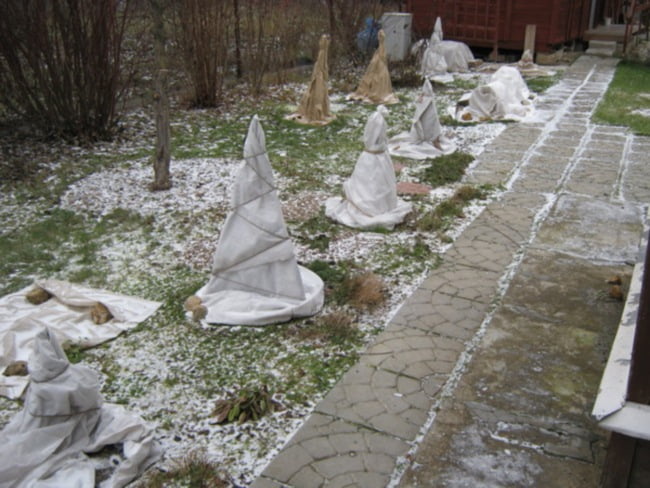

How to choose bulbs for autumn planting
The choice of high-quality planting material is the key to a beautiful and lush flowering in the future. It is recommended to choose garden lily bulbs according to the following guidelines:
- It must be clean, free from mold, rotting, and free from any stains.
- The normal size is at least 3-4 centimeters in diameter. It is not recommended to buy specimens less than 2 cm.
- The bottom is solid, has no damage.
- There should be no shoots on the planting material.
- The roots are healthy, without traces of drying out, rotting, mold.
- The bulb is dense, the scales fit tightly to it, do not fall apart. But soft, loose, lethargic or dry specimens should be avoided.
- As for the color of the planting material, there are no recommendations here, because the type and variety of the flower affects the shade, and not the quality.
Site requirements
Unpretentious lilies still impose certain requirements on the location of the flower bed and the composition of the soil. These plants have several dozen varieties, and each has its own characteristic features. One variety requires a lot of sunlight, while the other, on the contrary, reproduces better in partial shade. You should pay attention to this even when buying seed.
The universal rule for planting lilies in open ground is the presence of good drainage on the site. Flowers consume a lot of moisture. It is necessary for the normal absorption of nutrients from the soil through the root system. But stagnant water in the flower bed will inevitably lead to the formation of mold and rotting of the bulbs.
For this reason, flat and straight areas should be chosen for the flower garden. Sometimes lilies are planted on a small hill. You should not break a flower bed in a place where groundwater is located close to the surface of the earth.
There are also special requirements for the soil intended for bulbous plants:
- 1. The soil in the flower garden should be good for air and moisture. You can increase drainage properties with ordinary river sand. Sometimes finely chopped peat is used for these purposes. Consumption of substances per unit area of the site depends on the type of soil. In too heavy clay soils, wood ash is additionally introduced, which not only structures the soil, but also enriches it with microelements.
- 2. Lilies grow well in a neutral environment. For some varieties, planting on slightly alkaline or slightly acidic soils is allowed. You can neutralize the soil by adding lime, ash and peat. The choice of substance and its amount depend on the composition of the earth.
- 3. Too much organic matter with a high nitrogen content can provoke premature development of the green mass of the plant. This negatively affects the vitality of the bulb. It will be rapidly depleted due to the consumption of nutrients necessary for the flower to survive the winter frosts and prepare for spring growth.
The flower bed must be protected from cold northerly winds. Drafts are bad for the bulbs. It is advisable that snow does not stagnate on the site in the spring. No other bulbous vegetables or flowers should grow in the location chosen for the lilies during the last 3 years. These plants are prone to the same diseases, therefore, such a neighborhood is dangerous for ornamental culture.
How to plant lilies correctly, at what depth and in what pattern
If you want to plant lilies in the fall, follow the correct planting scheme: take into account the depth of the holes, the distance between the bulbs.Some growers determine to what depth to plant lilies by multiplying the length of the bulb by 3. This method does not take into account the mechanical properties of the soil: it is better to place them deeper in looser ones, in heavy ones, on the contrary, closer to the surface. The same applies to the distance between the lilies.
Planting bulbs is easy:
- grooves or holes are dug in the prepared area;
- coarse sand mixed with wood ash is placed on the bottom;
- the onion is placed in the hole so that the roots do not curl upward;
- covered with soil, compacted.
Watering plantings or not depends on the climatic characteristics of a particular region.
Bulbs, including sprouted
The planting scheme for lily bulbs also depends on the variety:
- Low-growing varieties are buried 10 cm for large and 8 cm for small bulbs, leaving 15 cm of free space between them.
- Medium-sized ones are planted 15 or 10 cm, depending on size, leaving 25 cm between them.
- Tall - to a depth of 12 to 20 cm with an interval of 30 cm.
- White-flowered hybrids sink only 2-3 cm.
If stored improperly, the bulbs often hatch before they enter the ground. The problem is that planting lilies with sprouts in the fall is undesirable. They will freeze and most likely die, and if they survive, they will bloom only after a year.
One solution is to plant the sprouted lily in a pot, and keep it in a brightly lit, cool place until spring, watering it moderately. You can do with the autumn sprouts in a different way: let them stretch up to 20 cm and twist them out of the bulb with rotational movements.
Planting lily babies in the fall is done in the same way, only they are buried in half and must be covered for the winter.
Bulb and seeds


When planting, the bulbs are buried 2-3 cm. They are planted several weeks earlier than the bulbs at the same interval, after keeping them in the refrigerator for several weeks at a temperature of 3-4 degrees. The fact that they are ready for planting is indicated by the hatched roots. Bulbules must be watered when planting, the beds are insulated.
Lily seeds are often sown in bowls at the end of winter and kept in the house until May. But you can sow them in the fall - so the plants will bloom a year earlier. Before sowing, the seeds are soaked in bleach or low concentration hydrogen peroxide. They are rarely sown, in grooves 3 cm deep. The beds must be watered and tamped. For the winter, they arrange a two-layer "fur coat": first, sprinkle with peat or sawdust, and close it on top with straw and branches.
How do you determine the right time to plant your bulbs?
For planting in the fall in open ground, it is advisable to take only those bulbs that were grown this season on their own or purchased from local gardeners. Lily bulbs should be clean, plump and not sprouted, and the roots should be alive, without rot, at least 5 cm long ...
The planting material purchased in the store is imported mainly from Holland. Since the climate there is somewhat different, the bulbs are dug up for sale in October-November, then dried, cooled and sent to Russia. They reach our counters in the spring, so it is better to plant them in the spring.
Sometimes it is quite possible to keep the bulbs bought too early. To do this, put them in a bag for storage, filled with moistened peat or sawdust, make holes for ventilation and store in a suitable place at a temperature of -2 to + 3 ° C - you can in the refrigerator.
Planting material is usually purchased in spring or autumn. When buying, you need to check the quality of the bulb. The main thing is that it is healthy, dense and without spots, and if there are roots, then they should not be dry and rotten. Bulb size matters a lot. A plant of small bulbs, with a circumference of less than 8-10 cm, may not bloom in the first season.
The bulbs should be planted as soon as possible after purchasing them and should not be allowed to dry out.During the division of the bulbs, they can be immediately planted without drying them into the soil. Before planting, it is better to store them in a cool place at a temperature of 0-5 degrees in moss, wet sawdust, perlite.
You can keep them in the lower compartment of the refrigerator in a plastic bag with holes filled with sphagnum or dry high peat. As a rule, under such storage conditions, the bulbs do not form a large sprout (more than 5 cm). They can be planted in a plastic greenhouse, pots, plastic bottles, protecting them from frost. Plants are transplanted into open ground together with a lump of earth only after the end of the spring frost.
For autumn planting, planting pits and soil should be prepared in advance, in summer. But if you did not have time to prepare a place for planting, then you can do this in the fall, only it will be necessary to compact the soil mixture so that after planting the soil does not settle too much. Since plants cannot tolerate stagnant moisture, with heavy soil, there should be good drainage at the bottom of the planting pit. It is also obligatory to refuel the planting pits with fertilizers. The soil substrate for lilies consists of leaf humus, or leaf humus with manure in a ratio of 1: 1, 1: 2, 1: 3.
It is necessary to take into account the need of various types of lilies for soil acidity. Weakly acidic soil is preferred by Asian, American or Oriental hybrids. Weakly alkaline soil - Martagon, Candidum and tubular hybrids. You can lime the soil with dolomite flour, wood ash or a small amount of lime. Increase acidity with peat, rotted sawdust, bark or needles.
Planting depth depends on the rooting of the species, soil composition and bulb size, from 2 to 4 cm from the soil surface to the top of the bulb. Lilies with stem roots form roots not only at the bottom, but also on the stem above the bulb, so they need to be planted deeper. Some species form roots only at the bottom; such plants with real roots are planted at a shallow depth.
Asian and La hybrids are planted to a total depth of 8 to 10 cm (for small bulbs and on heavy soils), and up to 12-18 cm (for large bulbs and on light soils). Tall tubular and oriental hybrids are planted deeper from 15 to 25 cm, respectively.
For late flowering lilies, planting the bulb deeply has its advantages. At a depth, the soil temperature is lower, which means that in the spring the bulbs start growing later and there is less chance of freezing of the shoots, and in the fall the soil at the depth keeps the summer heat longer, the lilies have time to ripen and lay a flower bud.
It should also be borne in mind that for any planting of a lily, the fertile layer of earth under the bulb must be at least 45-50 cm and drainage. Before planting, coarse sand is poured onto the bottom of the hole. The roots are straightened and sprinkled with sand. With the onset of active growth, they are not allowed to dry out, in dry weather they are regularly and abundantly watered and from time to time fed with liquid fertilizers. The soil around the plant is not loosened, but mulched with peat or compost.
First, you need to understand that usually experienced gardeners recommend planting bulbs in the spring so that the plant does not freeze and give the long-awaited buds. The question arises, in the fall, if planting material appeared or there is no other way out? You need to observe a few precautions - and the fragrant flower will delight you with lush flowering next year.
Choosing planting material
When it is best to plant lilies depends on the variety and weather conditions. When purchasing planting bulbs, you need to pay attention to the scales located near the core, they must be healthy, without rot or any spots. If only the outer parts of the lily scales are damaged, they are carefully trimmed without touching the bottom of the bulb, and immersed in a solution of potassium permanganate for 15-20 minutes.The concentration of the drug is selected "by eye", the liquid should be bright. If the bulbs have a dried out appearance, it is worth wrapping them for 10-20 hours with a damp natural cloth, and then immersing them in a pale manganese solution for 15 minutes. Dried, damaged bulbs will produce short and thin stems, with or without small flowers.
When deciding when to plant lilies, an important rule must be observed - we plant new plants separately. Purchased bulbs can be infected with dangerous viruses that can destroy an entire flower garden or flower bed. In early to mid-September, it is time for planting and transplanting medium-term varieties. This month is chosen due to the fact that the bulbs will be ready to move from the ground to a new place only 30-45 days after the end of flowering. During this time, it will pick up nutrients and restore damaged roots.
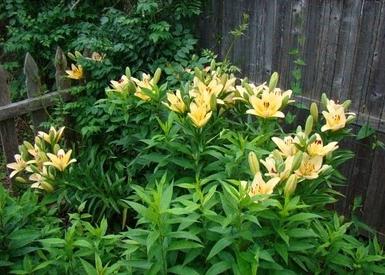

It is worth learning how to plant lilies in the fall if they are tubular varieties or unique oriental hybrids. The transplantation of these bulbs is usually planned for early to mid-October: you need to leave at least a month before frost so that the plant has time to strengthen. If the soil temperature drops below freezing Celsius, planting should be canceled before spring. A late bought bulb is still recommended to be buried, since in the warmth of the house the plant will first sprout, but then it will die immediately. in the fall, if all the deadlines have passed? You can use a little horticultural trick: we plant it deeper, water it with warm enough water and cover the garden bed very well from above.
Landing features
Asian hybrids need holes 8-11 cm deep for small bulbs to be placed on fairly heavy soils. Large specimens are planted 12-18 cm, mainly in light soil. Experienced flower growers suggest how to plant lilies in the fall, if they are tubular varieties. Such hybrids belong to the eastern tall representatives of the species, they are deepened by 15-25 cm. Since some varieties are not transplanted for 8-10 years, it is worth considering feeding in advance.
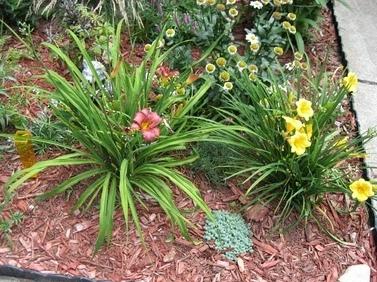

Dig a hole 50-60 cm deep and fill it with a mixture of high-quality compost and humus. In this prepared hole, a bulb will be planted, which will receive all the beneficial elements from the surrounding soil. It is very important to provide any reliable drainage - otherwise the roots will rot and the plant will die. In order not to accidentally dig up the plantings in the spring, you need to stick identification pegs near the bulbs. It will also be good to sprinkle all September plantings with wood ash, which is then slightly covered with soil on top. This method will reduce the acidity of the soil and increase future flowering.
When lilies are transplanted in the fall, special attention should be paid to the air temperature. If the weather is too warm, there is a high chance of germination of plants. This cannot be allowed in any way, otherwise all work will go to dust. The average daily daytime temperature should not exceed 10 ° C. Also, for the best result, we recommend taking into account the phases of the lunar calendar.
When planting lilies grown with your own hands, you must not rush. Remember: during flowering, the plant gives all its strength, so its bulb is very weak and loose. It will take about 2 months to recover. For example, lilies that have faded in July can be replanted as early as September. To do this, carefully, without damaging the roots, dig up the flower, rinse it with water and separate the processes from the main bulb. Then soak the "kids" in a weak solution of potassium permanganate for 30 minutes and dry in the shade. The roots must be cut so that their length does not exceed 10 cm.
Planting lily bulbs in the fall is recommended by botanists, since before the onset of cold weather, their root system has time to grow properly. Thanks to this, they are perfectly assimilated in the ground and withstand temperature extremes.Do you have several types of lilies in your garden? Then the transplant must be carried out in the following order: first white (they have the fastest recovery period), then Caucasian varieties, and closer to winter, American hybrids can also be planted.
Lily bulbs are well absorbed in the soil and tolerate temperature extremes
Soil preparation
The soil for planting is dug to a depth of at least 40 cm, removing the roots of the weeds. For digging, make:
- peat;
- sand;
- superphosphate;
- potassium sulfate;
- soil deoxidizer (dolomite flour or wood ash).
For Asiatic lilies, which grow well in acidic soil, it is not necessary to reduce the acidity.
Note! Lilies cannot tolerate fresh manure, bird droppings and unripe compost. When these formulations are added, the risk of fungal infections and burns on the surface of the bulb increases.
Useful tips for the gardener
To transplant and grow lilies, simple tips will help:
- late-flowering varieties are planted in spring;
- instead of a solution of potassium permanganate for disinfection, a solution of Fitosporin or another fungicide is suitable;
- flowers need watering from the second half of summer to late autumn;
- when sprouts appear, lilies are fed with nitrogen fertilizer;
- after flowering, lilies are fed with a potassium-phosphorus complex;
- in a rainy autumn, the planted lilies are covered with agrofibre, then they will better endure the winter;
- if the plants do not bloom for long and wither quickly, they need to be transplanted to a high bed;
- manure is not used to fertilize a flower garden, since it may contain pathogenic microorganisms.
Spring planting
In spring, purchased bulbs are most often planted, because at this time they appear on the shelves in a wide variety. When purchasing, it is recommended to carefully examine the planting material for rust and rot spots, signs of mold and diseases. It is best to choose large, healthy bulbs that have slightly hatched sprouts.
If the purchase happened in early spring, the bulbs must be kept intact before planting. To do this, they are placed in a polyethylene bag filled with sawdust, peat or sand and placed in a refrigerator. This way you can even save small-sized bulbs.


It happens that, through an oversight, poor-quality planting material is purchased.
The bulbs may have long shoots or be nearly dry.
Before planting in open ground, flower growers advise cutting plastic bottles, twisting drainage holes, filling with soil for seedlings and placing problem tubers there.
IMPORTANT! Do not forget about pre-treatment with growth stimulants and disinfecting solutions!
When to plant in open soil?
The land becomes suitable for planting lilies in May, after it dries well and warms up. To protect tubers from possible climatic troubles, they can be planted deeper, bulbs with long shoots are planted sideways, sprinkling the shoot with earth.
If there is a threat of frost on the soil, it is recommended to water the planted plants abundantly with clean water or with an ampoule of epin. Such a measure will weaken the creeping frost - wet soil will take a hit.
How to plant?
Landing technology not much different from the autumn, the plants are planted in the same way at the same depth.
ATTENTION! When planting tall varieties, it is immediately necessary to put a peg for support, so as not to damage the root system later.
If mice live on the site in summer, it is recommended to hide the bulbs in a metal mesh or special baskets for tubers.
During planting, they bringorganic fertilizers(infusion of mullein, wood ash), you can use ammonium or calcium nitrate and nitroammophos.
The planted bulbs are watered abundantly with water.
As you can see, there are no particular difficulties in planting lilies.
Any florist can handle this procedure.The most important thing is to read and remember all the tips given in our article. Who owns the information - owns the lilies!
Based on materials from the portal
Author of the publication
offline 4 years
Summing up
Lilies are quite hardy flowers. For their comfortable development and abundant flowering, you need to know and fulfill several simple conditions:
- Transplant is a mandatory operation for lilies. The frequency of this operation depends on the type of flower.
- The transplant is carried out only during the dormant period of the flower, which occurs a month after the end of flowering. The exception is Asian hybrid lilies, which can be transplanted at any time.
- The transplant time is chosen based on the climatic conditions and the variety of lilies.
- Depending on the time of transplantation, the flower needs its own care schedule.
Follow these rules, and the royal flower, according to legend, grew from drops of milk of the goddess Hera, the queen of the gods, will turn your flower bed into a piece of paradise!
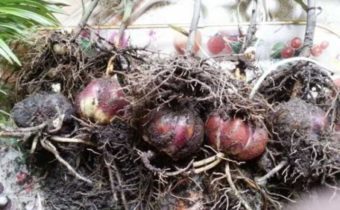

With graceful forms of luxurious flowers, exotic colors, lilies attract the attention of both experienced florists and beginners. For full growth and flowering, it is recommended to regularly replant the plants. Transplanting lilies to another location in the fall is beneficial for many species.
According to the International Classification, approximately 10,000 varieties of lilies are known. Popular hybrids:
Lily varieties also differ in flowering periods. And thanks to this, it is easy to choose plants so that exquisite flowers decorate the site, flower beds or paths throughout the summer season.
Soil preparation


Planting lilies requires well-drained soil.
A site for planting lilies is prepared in 30-40 days, so that the soil is compacted and settled. If you dig later, the bulbs in the loose soil will go deep, and the process of their germination in the spring will be delayed.
For digging for 1 m2, make:
- compost or humus - 5 kg;
- superphosphate - 100 g;
- potassium sulfate - 50 g.
The structure of the soil should be loose, air and water permeable. On heavy, clayey and non-water-intensive soils, conditions are created for bulbs to rot. It is unacceptable to place them in swampy places, in lowlands.
Storage rules
- the place where the bulbs are stored must be dry;
- humidity must be low, otherwise they will germinate;
- the temperature must be at least 5 degrees Celsius;
- the storage area needs air ventilation.
Based on the storage rules, the bulbs are placed in polyethylene with the addition of peat, then placed in a vegetable box and placed in a cool place. This will keep them at ease.
See also: "Subulate phlox: planting and care".
How to process
Experienced flower growers advised all sorts of means with which potatoes are treated from the Colorado potato beetle. However, I realized that it is not so easy.
The best preparations for myself today I have identified the following: "Enzhio", "Karate Zeon", "Ratibor".
If I identify a parasite on a bulb, process it and plant it, but then I make clear plans for next year. As soon as the shoots come out, I begin to process them on the sheet with a multiplicity of 20-30 days.
You can cope with the parasite. But, where is the guarantee that with the new planting material I will not bring it in again? Therefore, when buying new bulbs, I will certainly treat them with any of the listed insecticides.
Very often I practice the treatment of planting lilies when I spray the potatoes. I leave a little solution in the spray bottle and pass them along the shoots. The effect is good.

